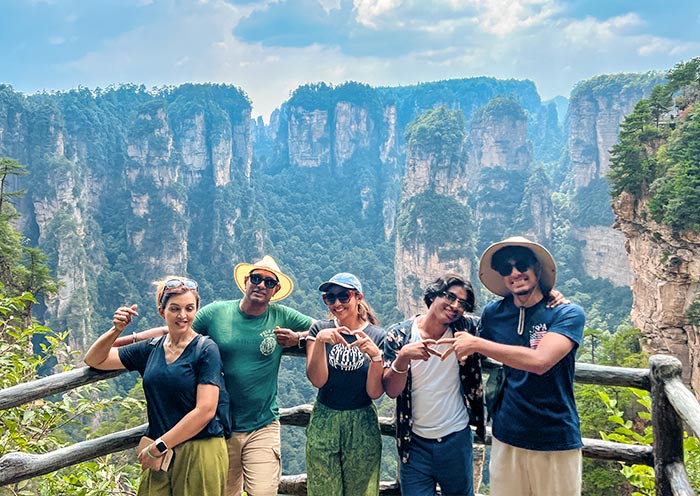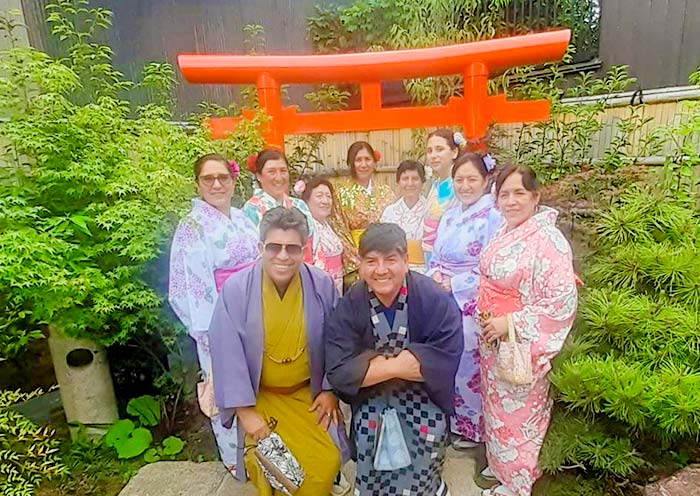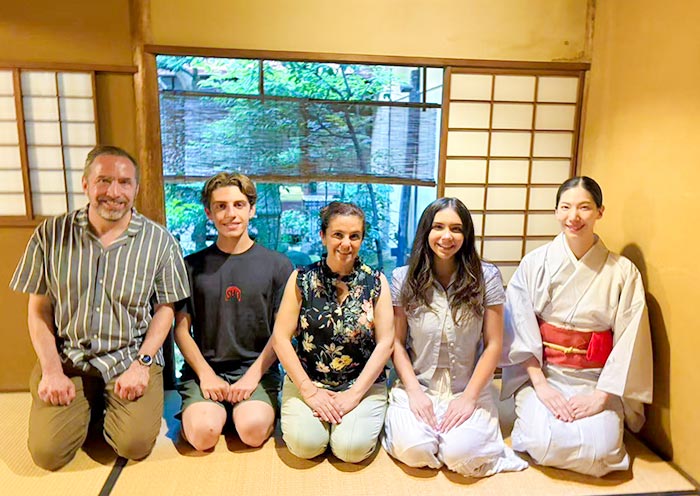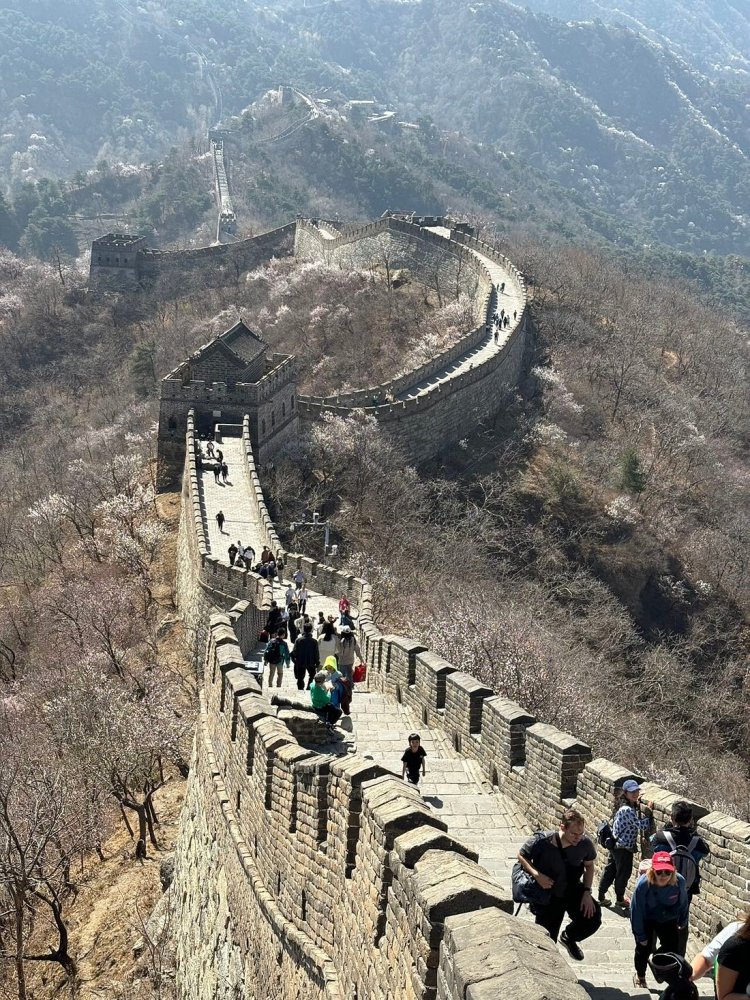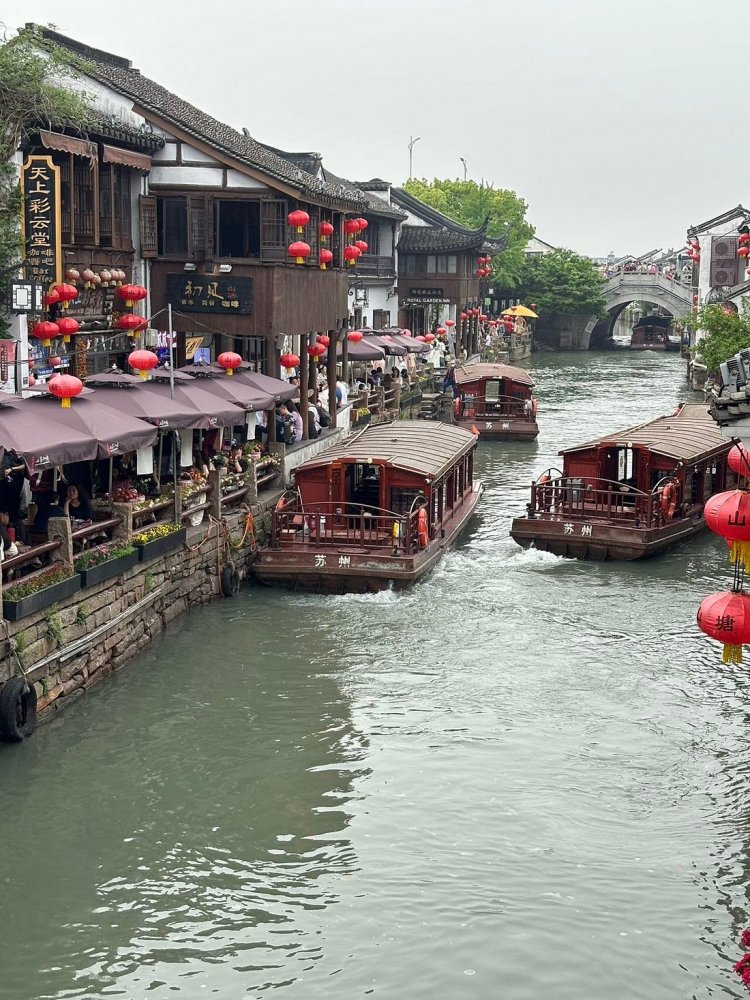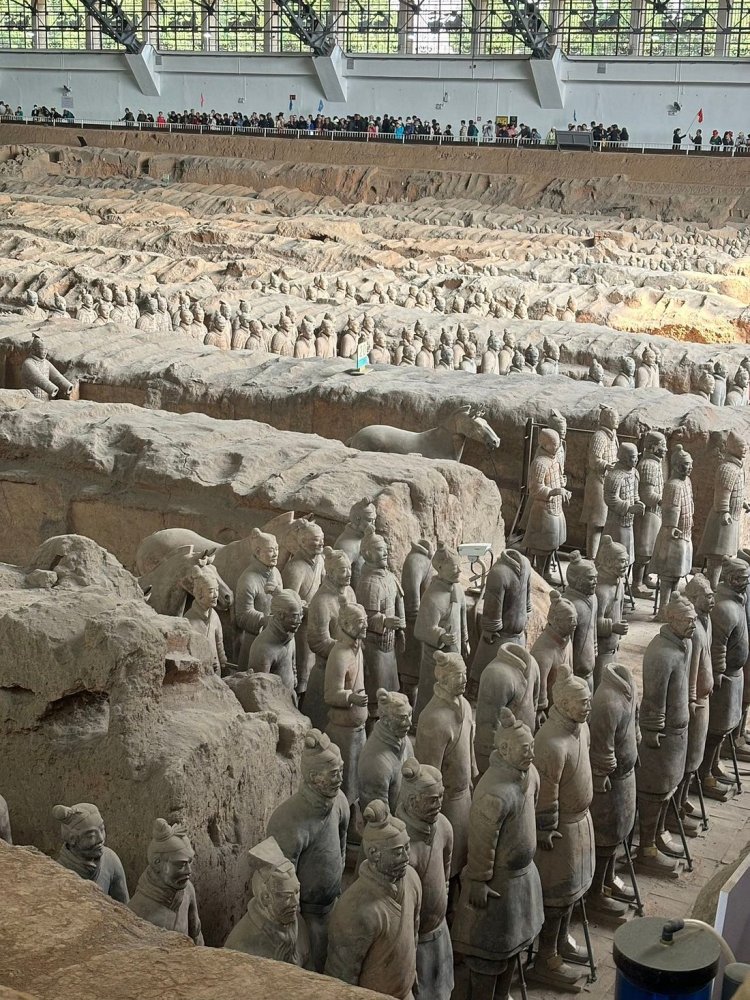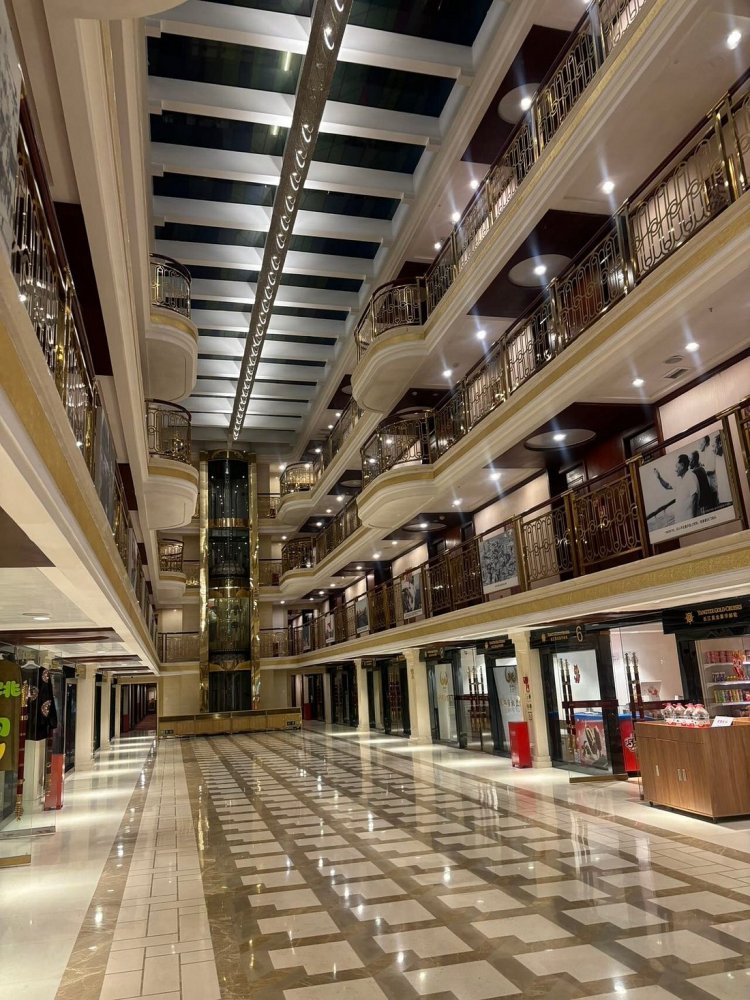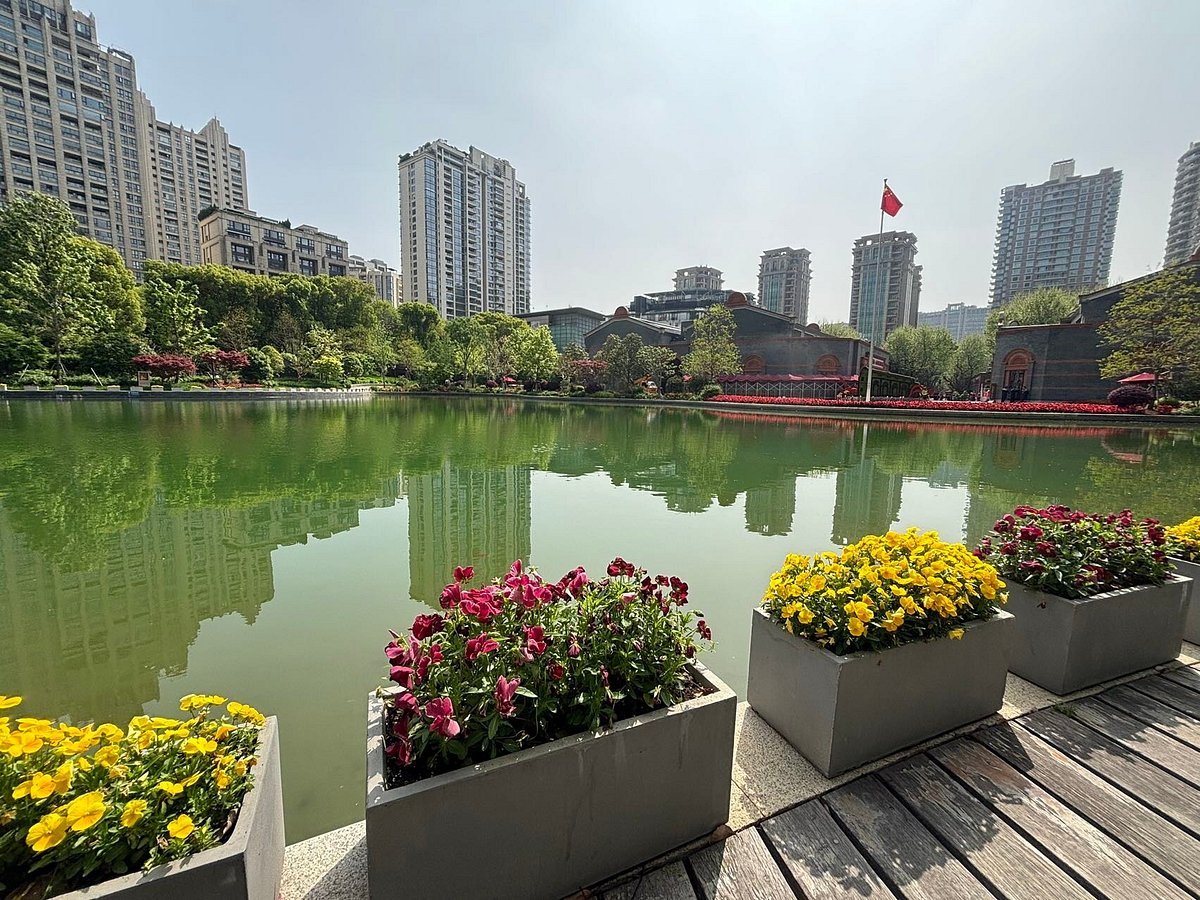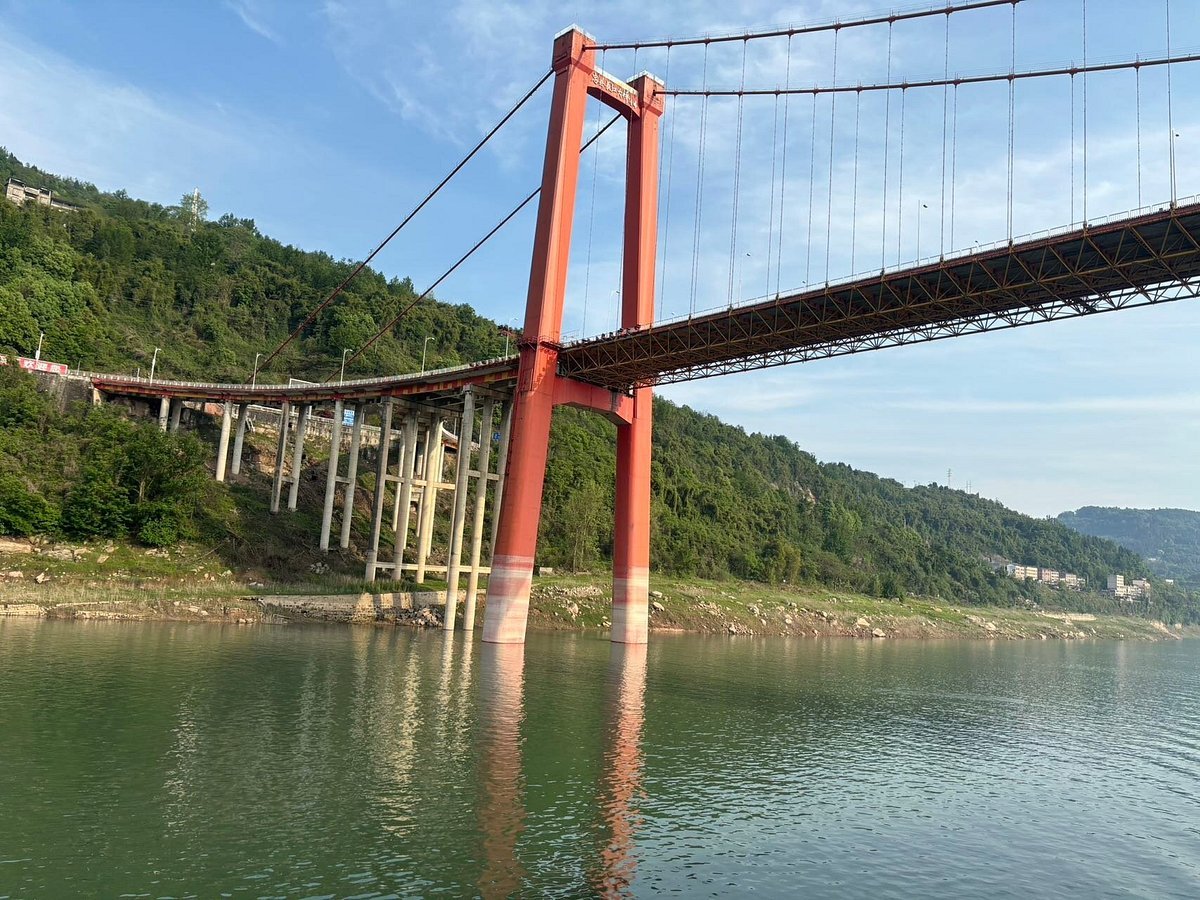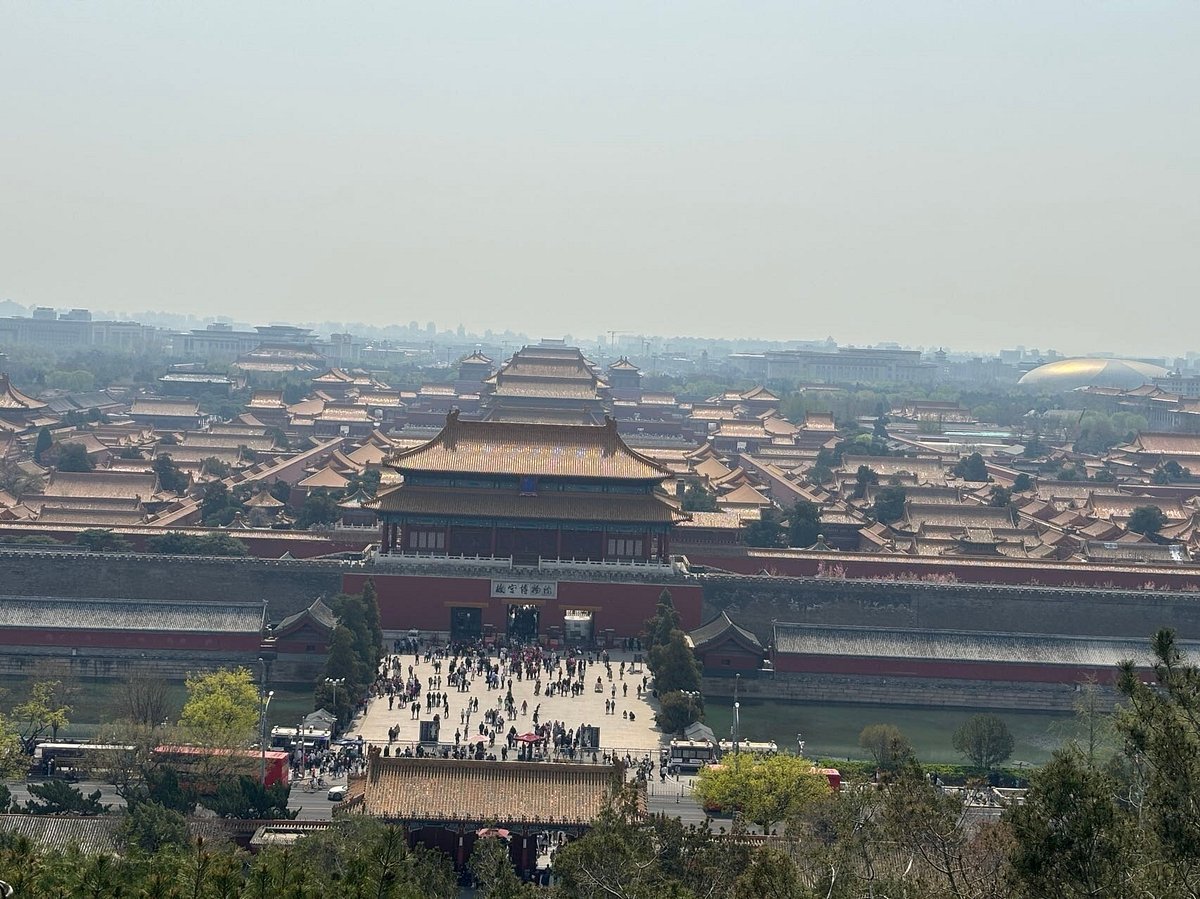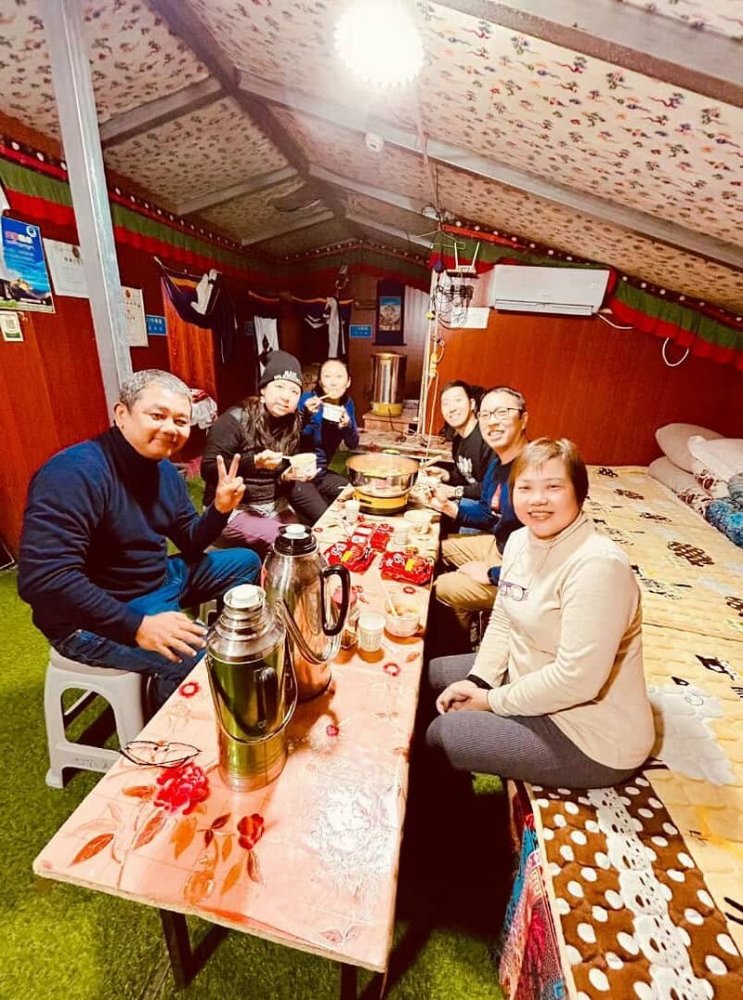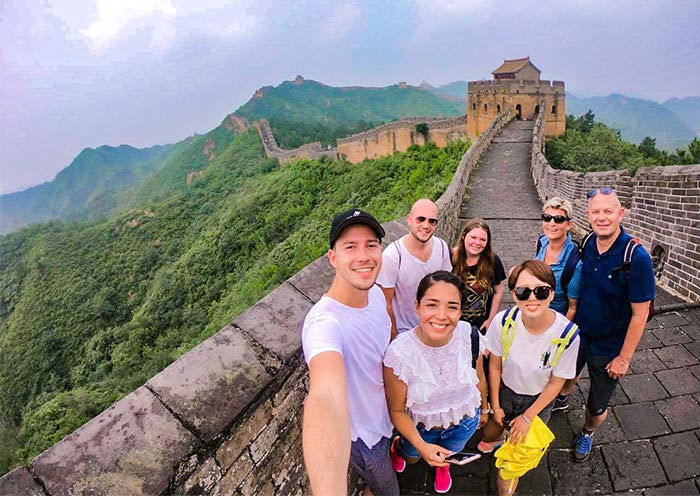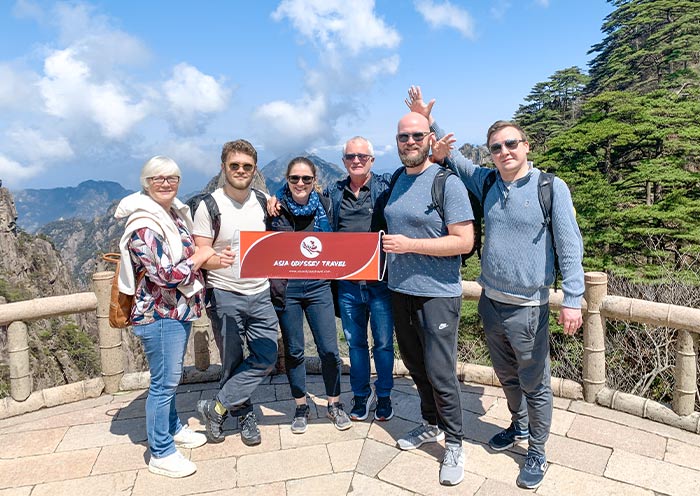17 Days China Japan Group Tour: Culture, Nature & Cherry Blossoms
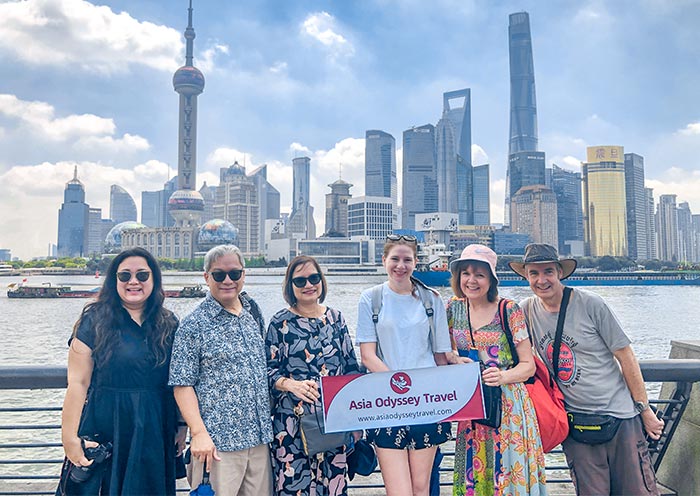
-
Tour Code: AOT-CNJP-01
-
Travel Route: Shanghai - Zhangjiajie - Xian - Beijing - Tokyo - Mount Fuji - Kyoto
-
Features: Culture, Nature, World Heritage, Cherry Blossom/Sakura, Temples, Shrines, Mountains, Modern Cityscape
-
Tour Type: Maximum 16 Pax
-
Guide & Driver: English-speaking guide, experienced driver with an air-conditioned vehicle
-
Accommodation: 3-star hotels in China and 4-star hotels in Japan
Lowest Price Guarantee. Reserve Now and Pay Later.
- Itinerary
- Dates & Price
- Accommodation
- Trip Notes
- Reviews
Looking for a smart-value way to explore China & Japan in one unforgettable trip? This 17 Days China Japan Group Tour takes you across the must-see highlights of nature and culture, with the chance to witness Japan’s famous cherry blossoms in full bloom.
China Essentials: The modern metropolis of Shanghai, the UNESCO natural spectacle of Zhangjiajie, the ancient imperial capital of Xi'an, and the majestic capital of Beijing. Japan Essentials: The global city of Tokyo, the sacred national icon Mount Fuji, and the traditional culture hub Kyoto.
Chase the Cherry Blossoms (Sakura): A highlight of this tour is the seasonal beauty of Japan, especially the enchanting Sakura. You'll explore iconic cherry blossom viewing spots, including the tranquil Maruyama Park and Kiyomizudera Temple in Kyoto.
Travel in small group (Maximum 16 Pax) for a personalized journey that’s budget-friendly yet high in quality, curated by Asia Odyssey Travel. Include multiple domestic/international flights (e.g., Beijing-Tokyo) and Shinkansen (Bullet Train) tickets, allowing for the most economical and smooth transition between cities and countries.
Itinerary Day by Day
- 2025 Itinerary
- 2026 Itinerary
Nihao! Welcome to Shanghai, China’s most internationalized and vibrant city! Shanghai's long-term fusion of Eastern and Western cultures has contributed to Shanghai's unique culture. Upon your arrival at the airport/train station in Shanghai, the driver will meet and greet you at the exit, and then escort you to the well-selected hotel in downtown Shanghai. The rest of the day is free on your own so you can have a good rest for the jet lag or explore by yourself around your hotel.
Arrival Ideas:
Travelers can go to Shanghai easily by air or high speed train. There are two airports - Shanghai Pudong International Airport and Shanghai Hongqiao International Airport operating numerous international and domestic airlines. Travelers can go to Shanghai by air from most cities in China, like Beijing, Xian, Guangzhou, Chengdu, Guilin, Kunming, Lijiang, Lhasa, and more. In addition, travelers can take high speed train to Shanghai from Beijing (4.5-6 hours), Xian (6-7.5 hours), Huangshan (2.5-3 hours), Guangzhou (7-8.5 hours), Suzhou (0.5 hour), Hangzhou (about 45 mins), Wuhan (3.5-4.5 hours), etc.

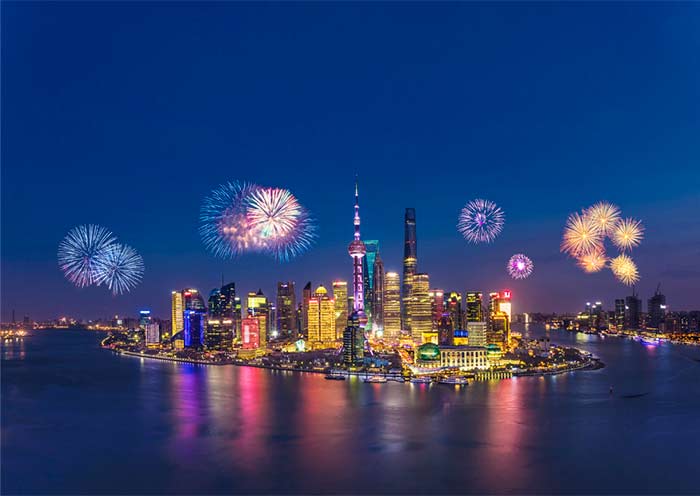
Attractions
Explore freely today
Transportation
Arrive in Shanghai by yourself
Dining
None
Accommodation
3-star hotel in downtown Shanghai
Today, your group will have full day to experience the perfect blend of East and West in the "Paris of the East." Explore brilliant museums, classical gardens, futuristic skyscrapers, and stunning architecture - all in one vibrant city.
First, head to Pudong and the Lujiazui financial district, home to a trio of iconic skyscrapers. The Shanghai Tower, China’s tallest and the world’s second-tallest building at 632 meters (2,073 ft), soars with a dramatic 120-degree twist from base to peak. Ride the world’s fastest elevators (64 km/h) to the "Top of Shanghai Observatory" on the 118th floor, 546 meters above ground. Enjoy breathtaking 360-degree views of the city, with the Jin Mao Tower and Shanghai World Financial Center below.
Later, visit the Shanghai Museum (East), one of the world’s finest museums of ancient Chinese art. Its sleek, modern design is inspired by the traditional Chinese jade bi disc. Inside, explore galleries of bronzes, ceramics, calligraphy, paintings, jade, furniture, coins, and sculptures. Don’t miss iconic treasures like the Da Ke Ding, a 3,000-year-old bronze vessel, displayed with the Zi Long Ding and Marquis of Jin Bells - a rare highlight of the Bronze Gallery. Also, see the legendary Sword of King Goujian of Yue, a masterpiece of ancient craftsmanship.
Next, visit Yu Garden, Shanghai’s most famous classical garden, hidden in the heart of the city. Stroll through elegant pavilions, rockeries, and lotus ponds, and admire exquisite carvings and traditional architecture. Outside, Yuyuan Bazaar offers local snacks, souvenirs, and handcrafted art.
In the afternoon, walk along Nanjing Road Pedestrian Street, lined with global brands, cafes, and historic buildings. End at the Bund, Shanghai’s top must-see landmark. Known as the "Exhibition of International Architecture," it features 52 grand buildings in Gothic, Baroque, and Art Deco styles. From here, enjoy a stunning view of the Pudong skyline across the Huangpu River.
Travel Notes:
- Yu Garden is closed on Mondays. In this case, we may visit the City God Temple, or French Concession
- Shanghai Museum (East) is closed on Tuesdays. You will visit Shanghai Museum (People’s Square) on that day. If access to the People’s Square location is unavailable, we will arrange an alternative city attraction.



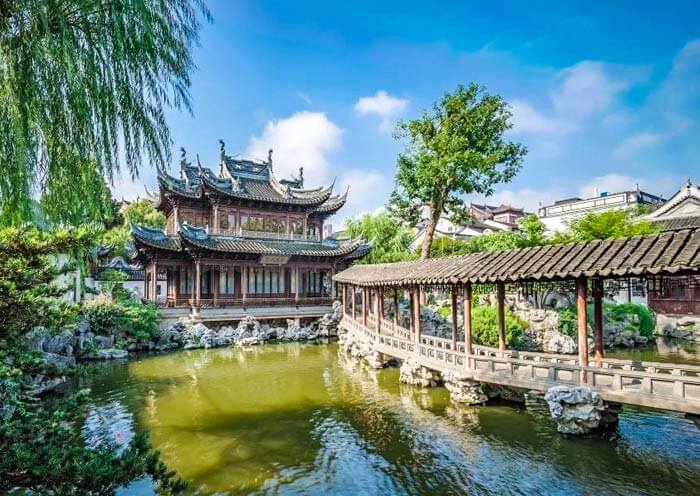
Attractions
5 iconic sites
Transportation
vehicle
Dining
Breakfast,Lunch
Accommodation
3-star hotel in downtown Shanghai
On this day, you will have some free time till be met in the hotel lobby and escorted to the airport for your flight to Zhangjiajie (about 2.5 hours).
Welcome to Zhangjiajie, an incredible place where you can see Avatar Hallelujah Mountain in reality! Upon your arrival in Zhangjiajie, the local driver will greet you at the exit of the airport, and then escort you to your hotel in Wulingyuan Area. Enjoy some free time on your own after the hotel check-in.
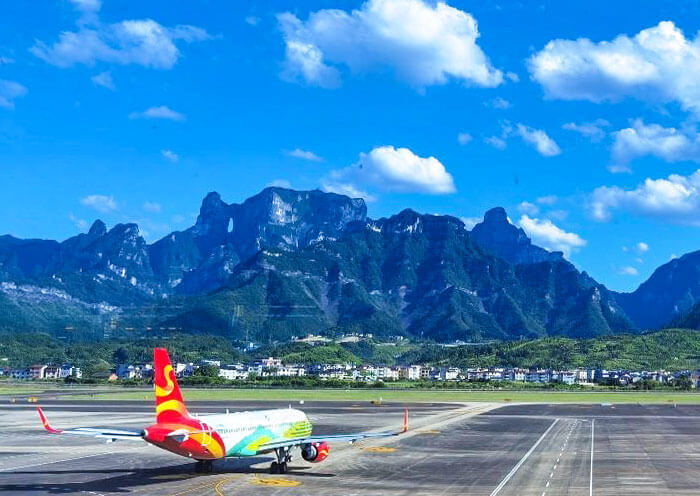

Attractions
explore freely on your own
Transportation
flight, vehicle
Dining
Breakfast
Accommodation
3-star hotel in Zhangjiajie
After breakfast, you will have a whole day to explore Wulingyuan Scenic Area, a spectacular island of nature dominated by more than 3,000 narrow quartz sandstone pillars. First, take a sightseeing bus to Bailong Elevator that within 1.5 minutes you can go from the valley bottom up to the pillar peak. It is the fastest and as well as the tallest outdoor elevator in the world. Next, enjoy the hike into a mysterious Pandora World - Yuanjiajie, where is rightly the shooting location of “Hallelujah Mountains” in reality. Catch the chance to shoot South Sky Pillar, the landmark of Yuanjiajie, about 150 meters high vertically rising high from the deep valley, looking like a giant standing so upright under heaven. Go to the Enchanting Platform for a marvel at the unbelievable scenery with hundreds of various peaks like bamboo shoots towering from the grounds. And then enjoy the lush scenery of Natural Bonsai at Backyard Garden.
Next, take the sightseeing bus to the second tourist site - Tianzi Mountain Nature Reserve which was named after the leader of the local Tujia ethnic group - Xiang Dakun in early Ming Dynasty (1368-1644). It is a fairyland in moive Monkey King. Hike to He Long Park which has a fascinating viewing deck to appreciate the incredible and magnificent scene of peculiar stone peaks. Move to Dianjiang Terrace to overlook the West Sea Stone Forest, rugged rock rising out of a misty canyon. The last stop today is the Ten-mile Galley. You will take a small green train to explore the beautiful scenery where you will feel like get through a Chinese ink painting. After the tour, get back to your hotel for a good rest.
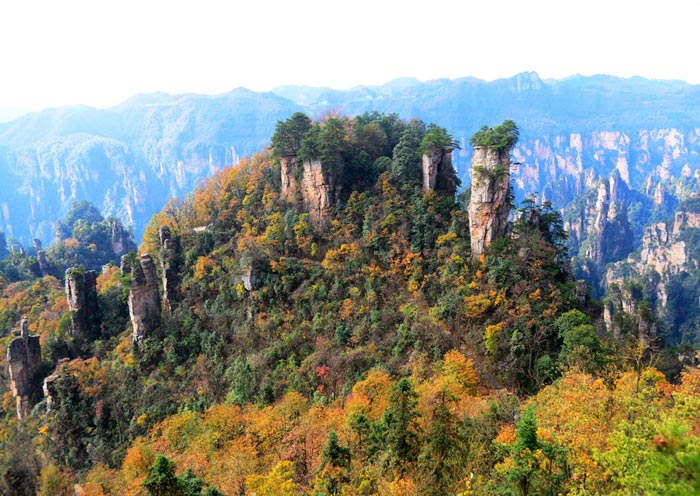
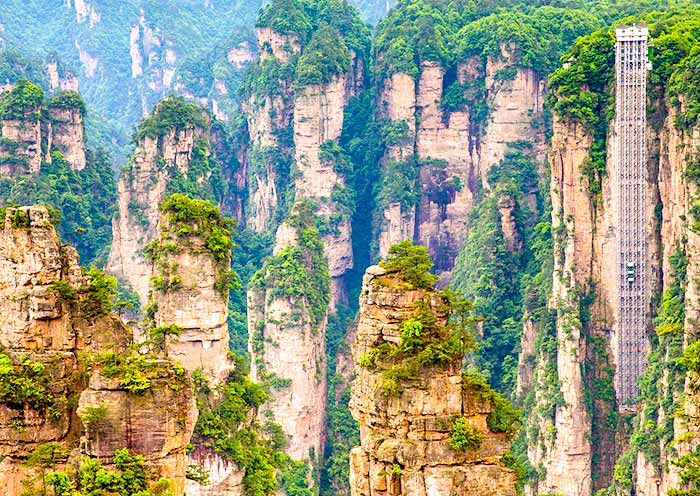

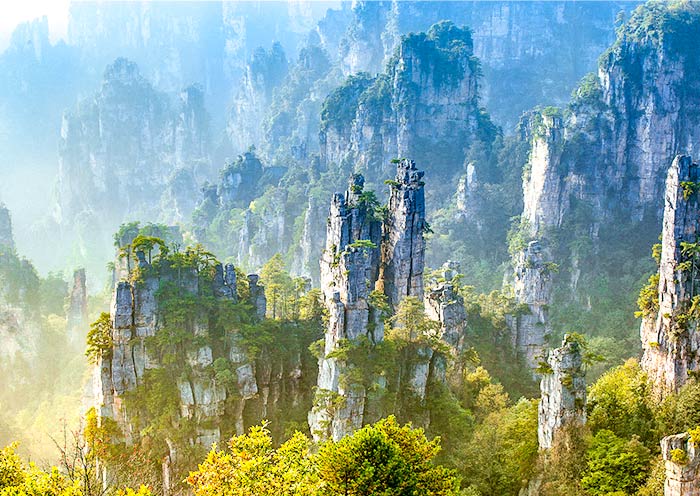
Attractions
3 sites
Transportation
sightseeing bus
Dining
Breakfast,Lunch
Accommodation
3-star hotel in Wulingyuan
After breakfast, you will be transferred to the Zhangjiajie Grand Canyon for the breathtaking Grand Canyon Glass Bridge experience. The Grand Canyon Glass Bridge wants to say “hello” to you and makes you yell “my god” to give a deeper impression of Zhangjiajie. Suspended between two peaks, the glass bridge is 430 meters long and 300 meters high, which is the longest and highest glass bridge in the world. Standing on the transparent glass is like floating in the air and you can have superb panoramic view of the entire Grand Canyon.
After your “tremble” on the glass bridge, move to the Baofeng Lake to do a scenic cruise to bring you back to peace. Surrounded by green trees and stone peaks of various shapes, Baofeng Lake is an idyllic place for relaxation. When leisurely cruising on the boat, you can see the reflection of the marvelous peaks and enjoy the folk songs performed by the local minority people.
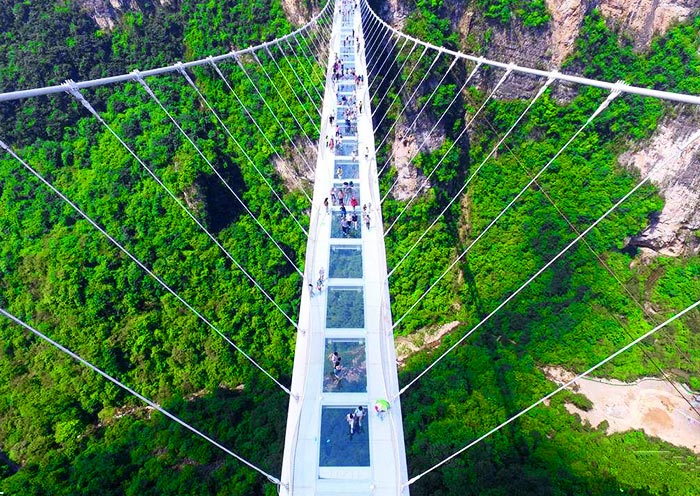
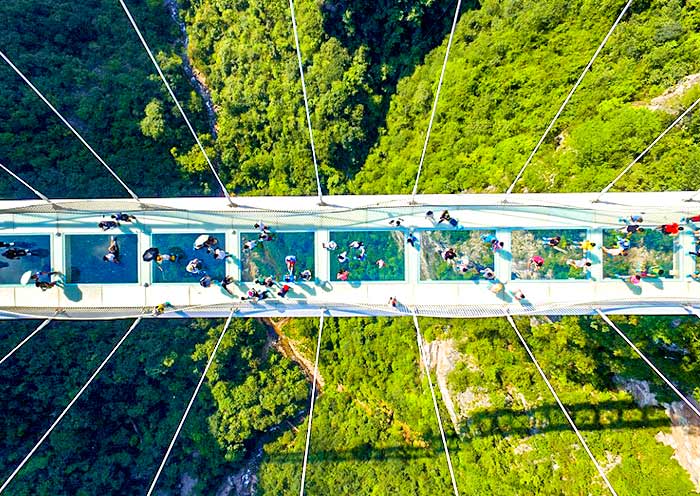


Attractions
2 sites
Transportation
vehicle
Dining
Breakfast,Lunch
Accommodation
3-star hotel in Wulingyuan, Zhangjiajie
After breakfast, your guide and driver will pick you up at your hotel lobby. Today, you will make a breathtaking visit to Tianmen Mountain, one of the world’s most beautiful mountains. You won’t miss the chance to experience the world’s longest cable car, walk on the glass skywalk, and pay a visit Heaven’s Door and view Avenue toward Heaven with 99 turns.
First, go to take the 30-minute cable car with 7,455 meters in length which means you’ll travel from the city of Zhangjiajie to the top of Tianmen Mountain. From the cable car you will have a perfect view of Heaven’s Door and a shocking look at the wandering Avenue toward Heaven. Next, move to Tianmen Temple where you can enjoy the typical Qing Dynasty styled Buddhist structure with verdant forest surrounding by.
Now, the challenge time is coming. Hold your breath to experience the scary walks on the cliff path hanging on the mountain. Walk on the Glass Skywalk, which is transparent glass 1430 meters above the bottomless valley, giving you a thrilling feeling like walking in the sky. Also, try the 1.6-kilometer-long Cliff-Hanging Walkway, built along the edges of the mountain’s summits. Amazing, isn’t it? After that, go down by escalator from the peak to Tianmen Cave which is also known as “Heaven’s Door”. Tianmen Cave is a natural arch between two peaks of a height of 131.5 meters, rising above the ground and closing to the sky with a lofty and towering posture. It is the highest hole of its sort in the world. (Note: Tianmen Mountain is the famous spot for Wingsuit Flying, you might have a chance to witness this unbelievable sport there.) After the memorable time, take the cable car down the mountain. And then, you will be transferred to Wulingyuan area and have accommodation here.
After the tour, it is time to say goodbye to Zhangjiajie. You will be escorted to the airport for your night flight to Xian (about 2 hours). Upon your arrival in Xian, the local driver will meet you at the exit of the airport and escort you to your hotel.
Optional Transfer Plan from Zhangjiajie to Xian in the Off-Season:
During the off-season, if there is no direct flight from Zhangjiajie to Xian, we will adjust the plan for you: transfer from Zhangjiajie to Changsha by high-speed train, and then take a flight from Changsha to Xian.


Attractions
1 site
Transportation
flight, vehicle
Dining
Breakfast,Lunch
Accommodation
3-star hotel in downtown Xian
After breakfast, your guide and driver will pick you up at your hotel. Drive about 40km (about 1 hour) to uncover one of the greatest archaeological discoveries in the world - the Terracotta Army Museum, built by the first emperor of China, Qin Shihuang, to protect him in the afterlife. Around 8,000 vivid life-size Terracotta Warriors have been found so far. First, visit the largest and most imposing pit, believed to contain over 6,000 terracotta figures of soldiers and horses. You will be amazed by this subterranean life-size army of thousands standing silently to guard the emperor. Marvel also at the fabulous artistic skills of ancient Chinese artisans. Next, move to another pit where you can see around 1,300 warriors and horses. Examine the ancient army formation, including the kneeling and standing archers, the chariot war array, and numerous troopers holding weapons.
After lunch, head to visit the Ancient City Wall, also known as the Fortification of Xian, representing one of the oldest, largest, and best-preserved Chinese city walls. Spend time leisurely walking the wall and enjoying its inner and outer walls, watchtowers, and moat, taking in panoramic views of modern Xian, there, you will also visit the awe-inspiring Bell Tower (or Drum Tower), a landmark from the Ming Dynasty dating back 600 years, will be beautifully illuminated, creating a captivating backdrop for stunning photos showcasing the harmonious blend of ancient history and modernity in Xian. In the evening, you may also have the chance to visit the lively Bell & Drum Tower Square (Zhongulou Square), allowing you to immerse yourself in Xian's vibrant nightlife like a local.


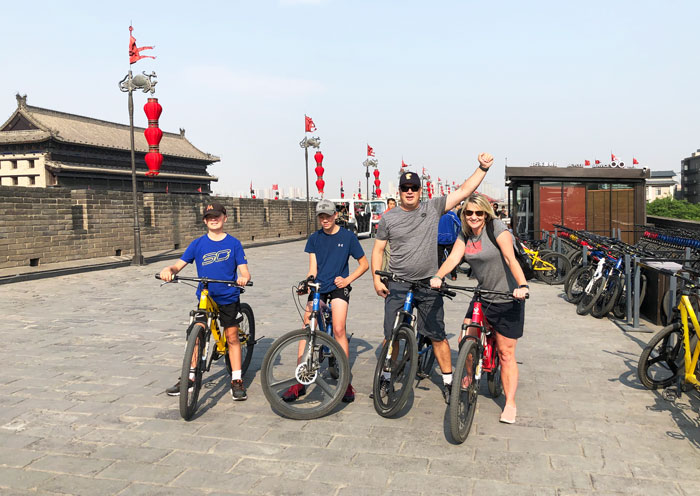
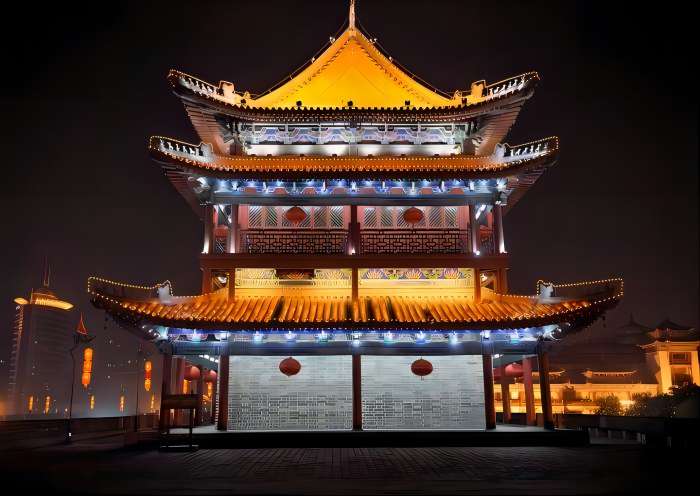
Attractions
3 sites
Transportation
vehicle
Dining
Breakfast,Lunch
Accommodation
3-star hotel in downtown Xian
This morning, you will go to visit the Giant Wild Goose Pagoda, one of Xi'an's most recognizable landmarks and symbol of the magnificence of the Tang Dynasty. This seven-story pagoda standing in the tranquil Da Ci'en Temple is one of China's best examples of a Tang-style pagoda (squarish rather than round). It was completed in AD 652 to house Buddhist sutras brought back from India by the monk Xuan Zang. His travels inspired one of the best-known works of Chinese literature, Journey to the West. Later, you will have the opportunity to explore the vibrant and bustling Muslim Quarter (Muslim Street). This historic quarter, situated just behind the Drum Tower about 430 meters west of the Bell Tower in downtown Xian, has been around for over 1,000 years.
After the tour, you will be transferred to the train station for your high speed train to next destination - Beijing. Upon arrival in Beijing, your driver will meet you at the train station and escort you to your hotel. The rest of the day is free on your own so you can explore by yourself around your hotel.
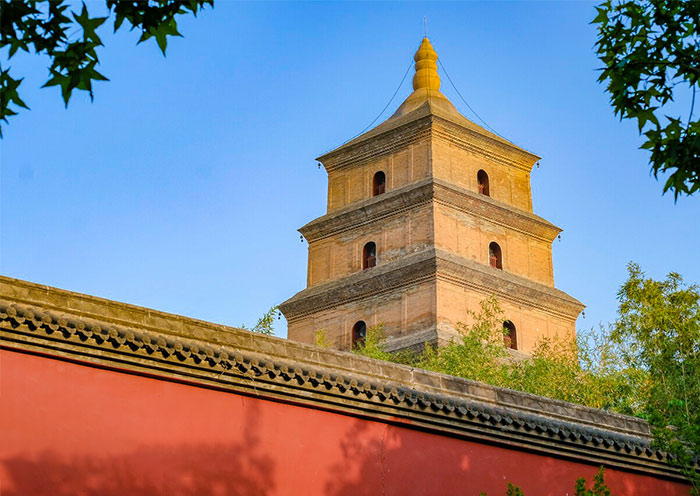
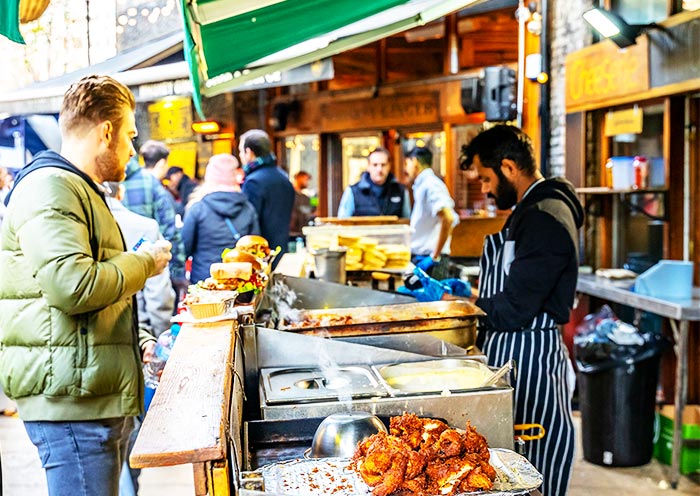
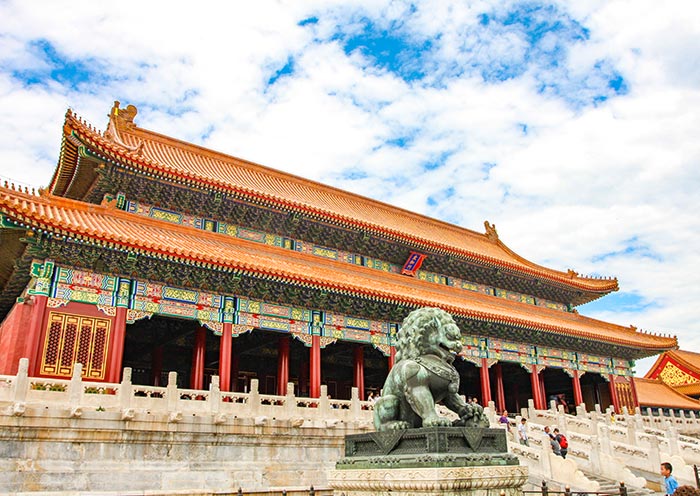

Attractions
2 sites
Transportation
high speed train, vehicle
Dining
Breakfast
Accommodation
3-star hotel in downtown Beijing
Today you will spend the whole day exploring the ancient citadel of Beijing through China's famous landmarks, imperial grandeur, and royal gardens.
After breakfast, your guide will pick you up at your hotel and head to Tiananmen Square, the world's largest public square and symbol of China. It has witnessed many major events in China's history over the past decades, and from here you can take great photos of Tiananmen Gate, seen daily on CCTV News.
Walking across the square, you will visit the mighty and splendid Forbidden City, the world's largest palace complex and former home of 24 Chinese emperors. Listed as a UNESCO World Heritage site, the Forbidden City has about 500 years of history, serving as the political and ritual center of China during the Ming (1368-1644) and Qing (1644-1911) dynasties. With over 8,700 rooms, it is not only China's largest and best-preserved collection of ancient buildings, but also a city within a city, like the Vatican in Rome. Enter through the Meridian Gate and visit along the central axis to ensure you see all the highlights. Admire the brilliant architecture and numerous ancient treasures while listening to your guide share stories of the emperors who once lived here. Later, take a 15-minute walk up to Jingshan Park, where you can enjoy magnificent panoramic views over modern Beijing and the Forbidden City's russet roofs. (Note: It requires some walking, so please wear comfortable footwear. You can decide whether or not to climb to the top based on your physical condition.)
In the afternoon, drive to the Summer Palace, the "Museum of Royal Gardens," once a summer retreat for royal families. The grounds, temples, gardens, pavilions, lakes, bridges, gate-towers, and corridors are marvels of landscape design. Take a leisurely stroll to appreciate the imperial architecture, hilltop views, and beautiful lakes, which offer a pastoral escape into the landscapes of traditional Chinese painting.
(Travel Note: The Forbidden City in Beijing is closed on Mondays. If your tour falls on that day, the itinerary will be adjusted to ensure you visit the Forbidden City.
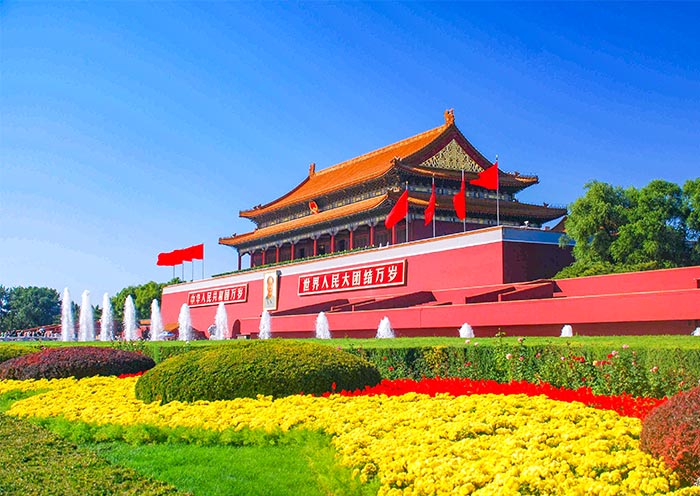
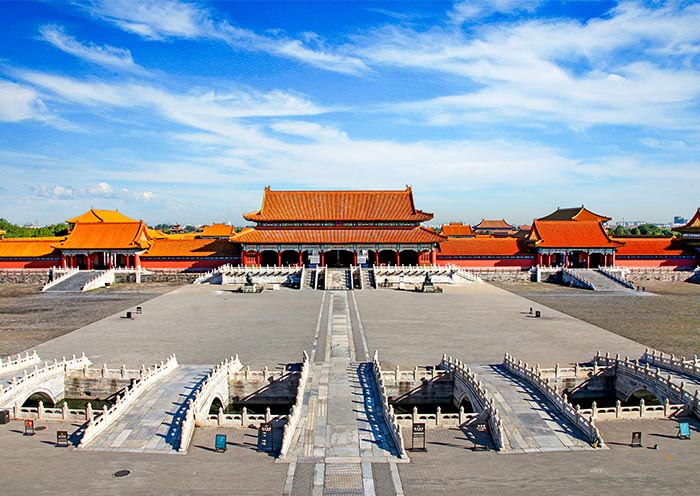


Attractions
4 iconic sites
Transportation
vehicle
Dining
Breakfast,Lunch
Accommodation
3-star hotel in downtown Beijing
In this morning, you will head northwest of Beijing (about 1.5-2 hours’ drive, 73km) to the Great Wall at Mutianyu. The Great Wall boasts a history over 2,000 years and stretches more than 3,000 miles across several provinces of northern China, making it one of the most impressive ancient masterpieces on the planet. Mutianyu Great Wall is connected with the Jiankou Great Wall in the west and the Gubeikou Great Wall in the east. Mutianyu is the longest and best fully-restored Great Wall with fewer tourists and is also famed for its 23 Ming-era watchtowers and stunning views. Take the cable car up to the 14th watchtower and then enjoy the memorable hiking time on the wall while visiting its western route. With the green pines and cypresses covering the surrounding area, and the winding wall standing majestically on the vast land, you will capture the most stunning natural scenery in this section. Challenge yourselves while climbing up to the 20th watchtower where you could fulfill your Great Wall dream. Cherish the chance and take photos as many as you like!
After the once-in-lifetime experience, head back to downtown Beijing and have the chance to take photos with the exterior of the Bird's Nest (Beijing National Stadium) and Water Cube (Beijing National Aquatics Center). They were both designed for the 2008 Beijing Olympics and used for the 2022 Winter Olympic Games.
After that, transfer back to your hotel and have a good rest tonight.
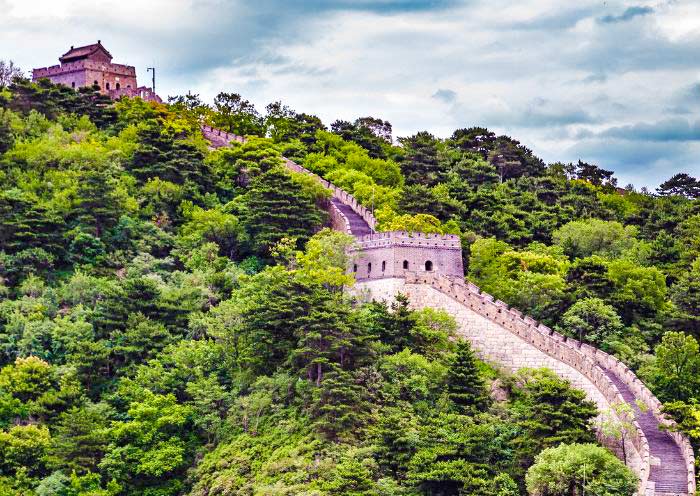
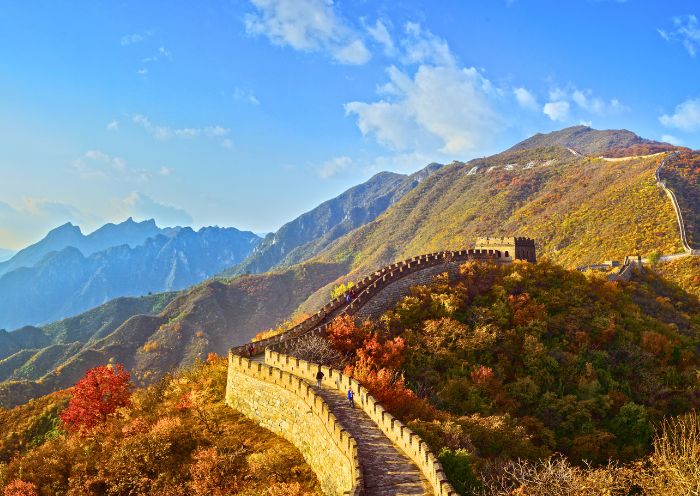

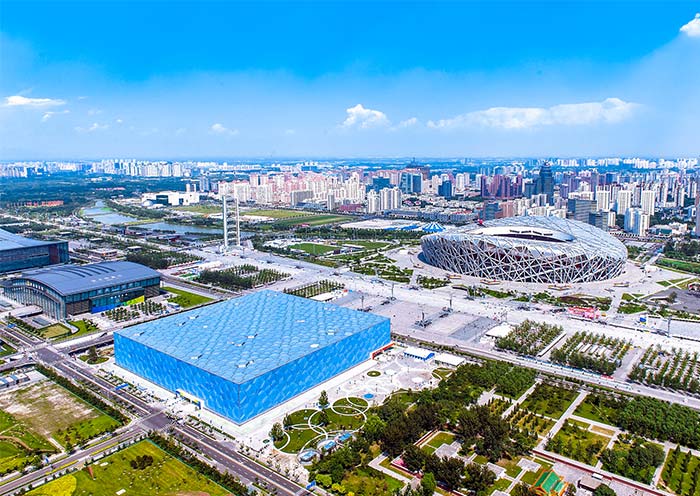
Attractions
3 sites
Transportation
vehicle
Dining
Breakfast,Lunch
Accommodation
3-star hotel in downtown Beijing
You will have some free time in Beijing and explore more on your own till be escorted to the airport for your flight to Tokyo.
Konnichiwa (こんにちは)!Welcome to Tokyo, the capital city of Japan!
Upon arriving at the airport, you will transfer to the designated hotel in Tokyo. The accommodation in Tokyo will be a 4-star hotel in a convenient location.
Tokyo, the capital of Japan, is one of Japan and Asia's largest economic centers. Tokyo is a hub for Japanese culture and art, with numerous museums, art galleries, theaters, and cultural venues, serving as a vital platform for artistic activities and cultural exchanges. Tokyo stands as a significant base for technological advancement, nurturing numerous high-tech companies and innovative talents, holding leading positions globally in areas like electronics, automotive, and robotics technology.
Situated at the southern end of the Kanto Plain, Tokyo is surrounded by diverse natural landscapes including Mount Fuji, providing residents with leisure and outdoor activity spaces. At one point, the population of the Tokyo metropolitan area reached 36 million, accounting for one-third of Japan's total population. Despite the high cost of living, Tokyo provides residents with convenient living conditions, offering a plethora of shopping centers, entertainment facilities, and a rich culinary culture ranging from fine dining to street food.
Attractions
/
Transportation
vehicle
Dining
Breakfast
Accommodation
4-star hotel in Tokyo
Full day explore Tokyo & Sakura (Cherry Blossom). In the morning head to Ueno Park. It is one of the city's largest parks and one of Japan's most famous cherry blossom viewing spots, boasting over 1,300 cherry trees. The cherry blossoms bloom every spring, especially in early April, creating a breathtaking spectacle of falling cherry petals carried by the wind. The park is home to numerous museums and art galleries, including the Tokyo National Museum (Closed on Mondays) and the National Museum of Western Art (a World Heritage Site). In Ueno Park, you can also hear the calls of Japan's national bird, the crow, as they fly and search for food.
After that, head to Senso-ji Temple (Asakusa Kannon Temple), a must-visit for anyone traveling to Tokyo. Here, you can experience the heart of old Tokyo and its vibrant atmosphere. You can take photos that frame Senso-ji Temple and the Tokyo Skytree (Japan's Tallest Tower; 634 meters) together. Senso-ji Temple is a great place to view cherry blossoms in Tokyo! The temple is located in Asakusa, a popular neighborhood known for its cherry blossoms. There are several cherry trees in the temple grounds, as well as in the surrounding area.
Senso-ji Temple was built in 628 AD and has a history of over 1300 years, making it one of Japan's oldest temples. It not only witnesses Japan's historical changes but also carries a rich Buddhist culture. The architectural style of Senso-ji Temple blends Japanese traditional culture and art, with rich colors and exquisite carvings. The main buildings include the main gate (Kaminarimon; a landmark of Tokyo), the bell tower, the five-story pagoda (a landmark of Tokyo), and the main hall, all reflecting ancient Japanese architectural style and religious beliefs.
Kaminarimon is the iconic structure of Senso-ji Temple, towering at 11.7 meters high and 21.7 meters wide, truly spectacular. Giant red lanterns hang in front of the gate, with the words "Kaminarimon" prominently displayed. Kaminarimon is not only a symbol of Senso-ji Temple but also one of Tokyo's most famous landmarks. You may have seen the work of Utagawa Hiroshige, one of the "Three Greats of Ukiyo-e," in his piece "One Hundred Famous Views of Edo: Asakusa Kaminarimon," depicting a snowy scene of the Kaminarimon gate, celebrated for its delicate portrayal and profound imagery, becoming a masterpiece of Ukiyo-e art. The area is bustling, and crowded with people coming to pray and seek blessings for health, peace, and happiness. Around Senso-ji Temple, you can taste various Japanese cuisines, purchase unique souvenirs, and participate in various celebratory activities.
In this afternoon, visit Meiji Jingu Shrine (Meiji Shrine), a Shinto Shrine dedicated to Emperor Meiji (1852-1912) and Empress Shoken (1849-1914), who played a crucial role in modernizing Japan while excelled in writing Waka (traditional Japanese poems of 31 syllables in the pattern 5-7-5-7-7). Meiji Shrine is also a popular venue for traditional weddings, where you will have the opportunity to witness a Japanese wedding procession and experience the charm of Japanese traditional culture.
The Meiji Shrine is nestled within a tranquil forest that covers an area of 70 hectares, providing a peaceful escape from the bustling city. This forest is home to over 100,000 trees that were donated from regions across Japan during the shrine's construction, in honor of their beloved Emperor Meiji (who established Shinto as the state religion) and Empress Shoken.
Take a stroll along the paths and enjoy the fresh air and natural beauty. You will walk through Japan's largest wooden Torii gate, standing in its natural wooden hue and weighing up to 13 tons. The Torii gate serves as the Symbol of Shinto Shrines, marking the transition from the worldly to the sacred. Then, you will notice the impressive Sake Barrel Wall along the South Approach, which features offerings from sake breweries and believers across Japan, including barrels of sake and Western liquor, reflecting Emperor Meiji's fondness for Western culture.
At the main hall of Meiji Shrine, you can witness locals washing their hands and rinsing their mouths at Purification Font before worship as a sign of respect. You can offer a 5-yen coin (symbolizing a connection) like locals and pray for blessings. In the eyes of the Japanese, Meiji Shrine is considered to have such boundless capabilities, from naming ceremonies for newborns, to coming-of-age ceremonies, graduation ceremonies, seeking marriage partners, praying for world peace, family well-being, safe travels, good health, warding off calamity, etc.
In addition to immersing yourself in Japanese Shinto traditions and architecture, revel in the enchanting surroundings filled with lush trees, serene ponds, graceful bridges, and stone pathways that epitomize the essence of traditional Japanese garden art. You should visit here to enjoy the vibrant bloom of cherry blossoms in spring, the verdant beauty of summer, the fiery hues of autumn leaves, and the serene snowy landscapes of winter.
Tips for Visiting Meiji Jingu Shrine:
- Wear modest clothing: Respect the sacred nature of the shrine by dressing appropriately.
- Be mindful of noise levels: Maintain a quiet and respectful atmosphere.
- Inner Garden (Optional; self-pay; once Imperial Property), and Meiji Jingu Museum (Optional; self-pay; items used by the imperial couple).
Then, move to visit Shibuya Crossing, one of the busiest intersections in the world, accommodating approximately 3,000 people per minute. As one of Tokyo's iconic locations, Shibuya attracts tourists and photographers from around the globe who come to observe and capture its essence. Numerous movies, TV shows, commercials, and music videos are filmed at this location, such as "The Fast and the Furious: Tokyo Drift." Additionally, if you're interested in the story of Hachiko, the loyal dog, you can also visit his bronze statue. This Hachiko Statue is located outside Shibuya Station and was erected to commemorate Hachiko's loyalty. Not only is it a popular meeting spot, but it's also a must-visit attraction for tourists. The statue symbolizes the power of loyalty and love, serving as a touching tribute.
Stay overnight in Tokyo.
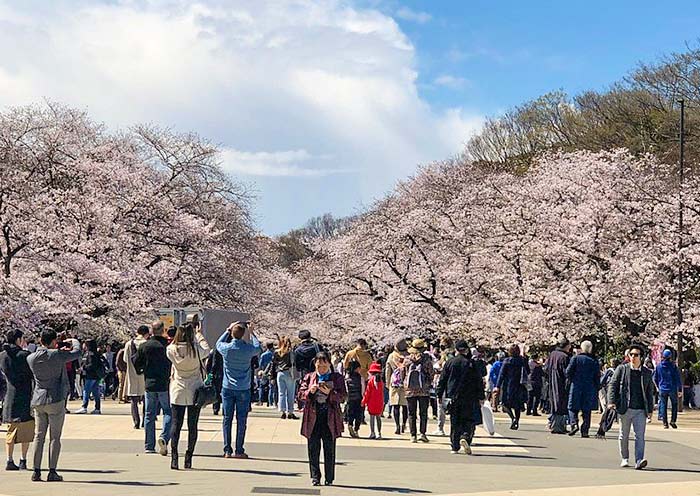

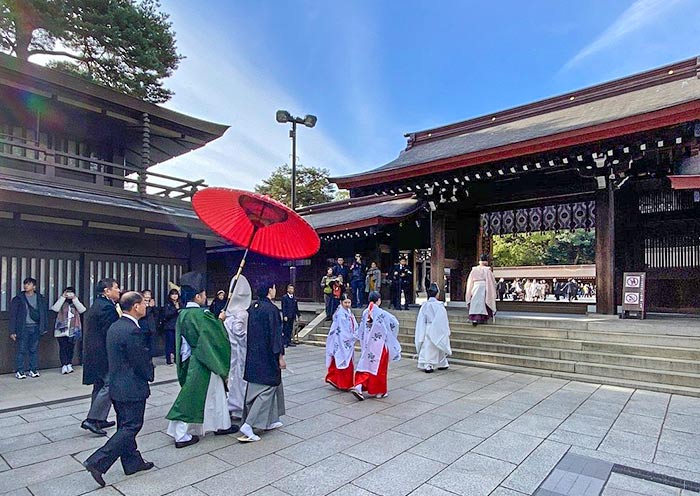
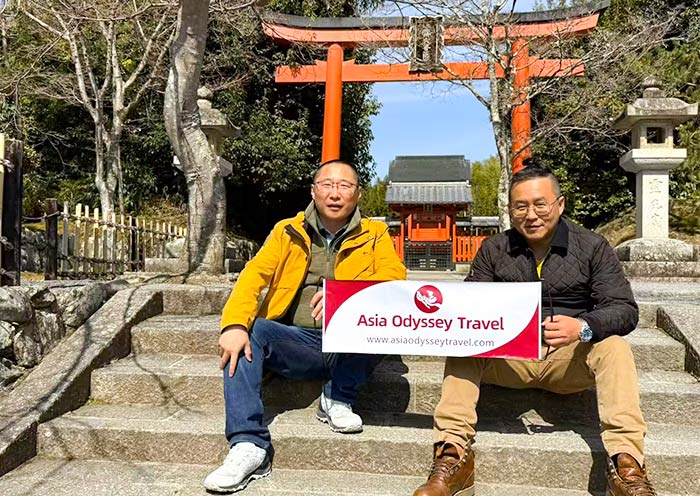
Attractions
4 Sites
Transportation
Vehicle
Dining
Breakfast
Accommodation
4-star hotel in Tokyo
Today, it will be a full-day round trip to admire the breathtaking views of Mount Fuji from Lake Kawaguchi,
Mount Fuji is the tallest mountain in Japan. It's a famous volcano with a perfectly symmetrical cone shape. Visiting Mount Fuji is essential for any traveler in Japan. As a UNESCO World Heritage Site, Mount Fuji (3,776m) stands as an iconic symbol of Japan, a cultural and spiritual landmark (recognized as a holy mountain in Shintoism), and a natural marvel. When picturing Mount Fuji, its distinctive perfect cone shape and snow-capped peak likely come to mind. Among the most renowned depictions is Katsushika Hokusai's 'Thirty-Six Views of Mount Fuji'. Hokusai, one of the "Three Greats of Ukiyo-e", is best known for his masterpiece "The Great Wave off Kanagawa" which can be seen on the 1,000 Japanese yen bill.
Start your journey to Arakurayama Sengen Park on the way to Lake Kawaguchi. Arakurayama Sengen Park is a popular destination for viewing cherry blossoms, renowned for its early blooming sakura trees. The park features Kawazu zakura, a unique variety of cherry trees known for its large, pink blossoms. The park's cherry trees typically bloom earlier than those in other regions of Japan, making it a great choice for those who want to experience the beauty of Sakura in February or early March. The park offers breathtaking views of the Kawazu River and surrounding mountains (framing Mt. Fuji, Sakura & Five-story pagoda together), providing a picturesque backdrop for your cherry blossom experience. During the peak cherry blossom season, the park hosts a lively festival with food stalls, traditional performances, and other festivities. Hike about 15-20 minutes up to Arakurayama Sengen Shrine, dedicated to the mountain god. The shrine is surrounded by beautiful gardens and offers a peaceful atmosphere. Enjoy the gorgeous scenery and capture iconic photos at the famous Red Fuji Observation Deck.
Next, head to Lake Kawaguchi, another excellent location to leisurely view Mount Fuji. The lake boasts crystal-clear waters, providing breathtaking views of the iconic mountain and a serene atmosphere. Enjoy a cruise on the tranquil waters to marvel at the stunning reflection of Mt. Fuji in Lake Kawaguchi. Additionally, take a leisurely stroll around the lake and explore the nearby parks, galleries, and museums based on your interests.
After that, head back to Tokyo overnight and have a good rest.
Notes:
It is a long day trip, and there will be a surcharge if the tour exceeds 8 hours (For Guide, driver & vehicle).
If the weather is clear, you can enjoy a good view of Mt. Fuji. However, if the weather is not favorable, Mt. Fuji may not be visible.
The best time to view Mount Fuji is generally from December to February when skies are clearer and the peak is snow-capped. And also, April to May (for blooming cherry blossoms) and October to November (for the autumn foliage) are good times.
Early mornings often provide the best visibility before clouds obscure the view. Different locations around Mount Fuji offer varying perspectives, with some spots known for their clear views.
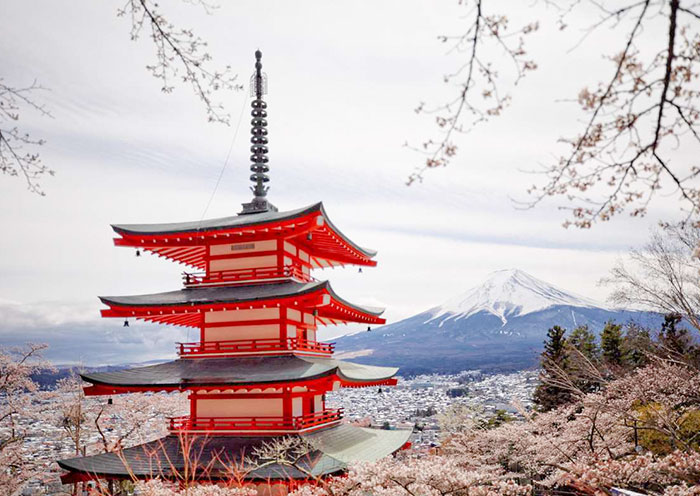
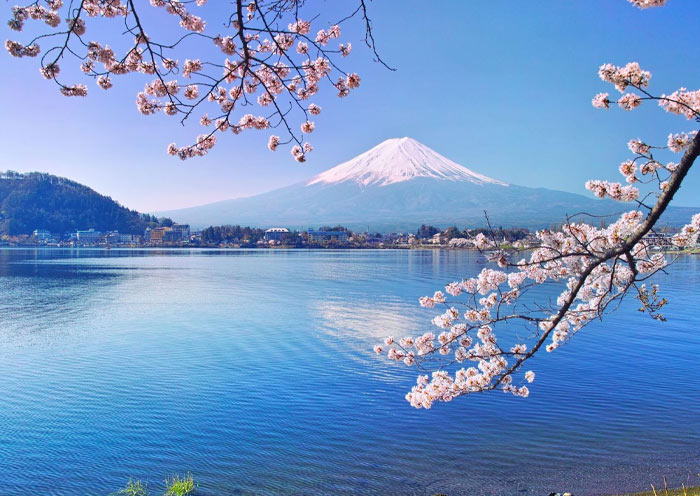
Attractions
2 Sites
Transportation
4-star hotel in Tokyo
Dining
Breakfast
Accommodation
4-star hotel in Tokyo
On this day, your driver in Tokyo will take you to the train station, where your group will board the Shinkansen (bullet train) to Kyoto. Shinkansen Ride Experience: At Tokyo Station, board the Shinkansen bound for Kyoto Station (about 2.5 hours). This fast and comfortable journey offers an opportunity to enjoy the changing landscapes of urban and rural Japan.
Upon arrival in Kyoto, your driver will greet you and transfer you to your hotel. Check in, take some time to settle in, and rest.
Kyoto, located in the Kansai region of the country, was once the capital of Japan. It epitomizes ancient Japan and is famous for tranquil temples, exquisite gardens, colorful shrines, grand imperial palaces, and ornate castles. Boasting 17 UNESCO World Heritage Sites, over 1,000 Buddhist temples, and more than 400 Shinto shrines, Kyoto is among the world's most culturally rich cities. It's also known for traditional Japanese arts and practices, such as tea ceremonies, kaiseki dining (a traditional multi-course meal), and ikebana (flower arranging). It remains one of the best places to see geishas, who are traditional Japanese female entertainers known for their refined skills in arts, music, dance, and conversation.
Free Time Ideas in Kyoto:
Evening Stroll Along the Kamo River: This river flows through the city and provides walking paths with beautiful views. Many cafes and restaurants along the river have terraces, perfect for a relaxing end to your day.
Walk the Philosopher's Path: Enjoy a peaceful walk along the Philosopher’s Path, a stone path lined with cherry trees that follows a canal in northeastern Kyoto. This path is especially beautiful during cherry blossom season but offers a serene experience year-round.
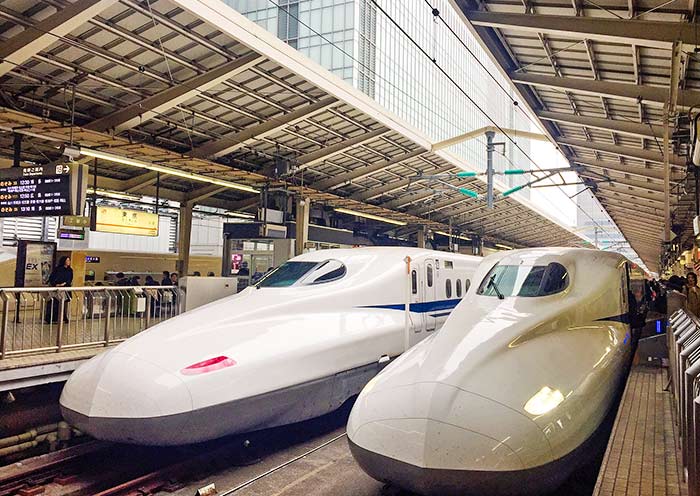
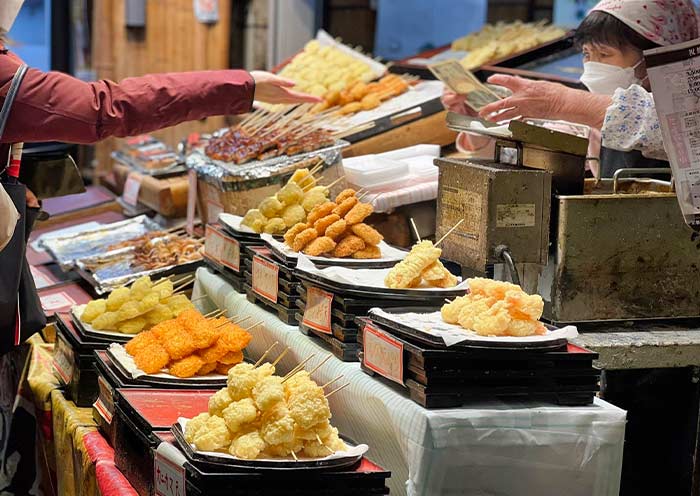
Attractions
/
Transportation
Shinkansen, Vehicle
Dining
Breakfast
Accommodation
4-star hotel in Kyoto
In the morning, visit Kiyomizudera Temple, a UNESCO World Heritage Site. Perched on the hillside of Eastern Kyoto, this temple is renowned for its wooden stage that juts out over the hill, providing stunning views of the city and the surrounding nature. The temple's main hall, constructed entirely without the use of nails, is an architectural marvel. Kiyomizu-dera is also celebrated for its sacred waters, which are believed to have wish-granting powers that draw countless visitors who come to drink from its stream. Don’t miss the Hondo (Main Hall), Jishu Shrine, the Otowa Waterfall, and the spiritual experience of the Tainai-Meguri room.
Tips: The scenery at Kiyomizu-dera Temple is distinctively beautiful in each season, offering a unique charm year-round. In spring, the mountains are adorned with charming cherry blossoms; in summer, they are lush with vibrant greenery; in autumn, they are decorated with brilliantly colored leaves; and in winter, they are filled with enchanting trees. You will enjoy the soft pink sakura ice cream (specially prepared for free by Asia Odyssey Travel) while having a wonderful time here.
Then, walk up the well-preserved streets of Ninenzaka and Sannenzaka. These charming, sloping streets are lined with traditional shops and quaint tea houses, offering a nostalgic glimpse into Kyoto's past. As you stroll through these areas, you can shop for unique crafts, sample local snacks, and perhaps stop at a café to relax and soak in the atmosphere of old Kyoto.
Continue to Maruyama Park for viewing Sakura. Located near Kiyomizu-dera Temple and Gion District, Maruyama Park is renowned for its stunning display of sakura, particularly the iconic weeping cherry tree (shidarezakura) near the shrine. The park is home to Yamataka-no-Otoko Shrine, a popular Shinto shrine that attracts many visitors throughout the year.
Next, move to Gion which is Kyoto's famous geisha district. Here, you might catch a glimpse of Geisha (Geiko) in their elaborate kimonos and traditional makeup. As you wander through the cobblestone streets of Gion, take a moment to appreciate the beautifully preserved machiya (wooden townhouses), ochaya (teahouses), and exclusive ryotei (traditional Japanese restaurants). Gion is particularly enchanting at dusk when the lanterns are lit and geishas and maiko (apprentice geishas) make their way to evening appointments, making the narrow lanes come alive.
The final activity today is to experience a traditional tea ceremony in an authentic setting, following the artful rituals and savoring the tea. Immerse yourself in the philosophy behind the ceremony.
After the tour, your group will be escorted to your hotel in Kyoto.
Attractions
5 Sites
Transportation
Vehicle
Dining
Breakfast
Accommodation
4-star hotel in Kyoto
Today, you'll be visiting some of Kyoto's most iconic spots, then head to the Arashiyama and Sagano areas located in the northwest of Kyoto. This itinerary will not only allow you to deeply experience Kyoto's culture and history but also bring you closer to nature, letting you feel the changes of the seasons.
Start your day with a visit to one of Kyoto's most iconic sights, Kinkakuji Temple (Golden Pavilion) - a UNESCO World Heritage site. This Zen Buddhist temple is famous for its stunning golden exterior. The temple's stunning visual appeal comes from its top two floors, which are completely covered in gold leaf. The reflection of the golden structure shimmering in the pond in front of it, makes it perfect for photos and quiet reflection. It was originally built in 1397 as a retirement villa for Shogun Ashikaga Yoshimitsu. After Yoshimitsu's death, as per his will, the villa was converted into a Zen temple by his son.
Next, head to Nijo Castle, another UNESCO World Heritage site, to delve deeper into Japan’s feudal history. Constructed in 1603 as the Kyoto residence of Tokugawa Ieyasu, the first shogun of the Edo period, its expansive grounds and ornate architecture highlight the power and wealth of the dominant samurai clans during the Edo period (1603-1867).
The castle features two concentric rings of fortifications, each consisting of a wall and a wide moat. After passing through the grand Kara-mon (gate), you will enter Ninomaru Palace, which is divided into five buildings with numerous chambers. The interiors are adorned with masterful paintings by the Kano school, reflecting the cultural and artistic heritage of the era. The castle is renowned for its "nightingale floors," (that sing and squeak at every move, making it difficult for intruders to move about quietly), designed as a security measure against intruders. Don’t miss the excellent Ninomaru Palace Garden, which was designed by the tea master and landscape architect, Kobori Enshu. Nijo Castle holds a significant place in Japanese history. It was at Nijo Castle in 1867 that Tokugawa Yoshinobu, the 15th and last shogun of the Tokugawa dynasty, declared the restoration of imperial rule, leading to the Meiji Restoration. This event marked the end of the shogunate system in Japan and the beginning of modern Japan as a nation-state.
This afternoon, you will fully explore the Arashiyama area in the western part of Kyoto. Based on Sakura season ticket availability, take one of the following two experiences:
Option 1: Sagano Scenic Railway Experience (25-30 minutes)
The Sagano Scenic Railway is a sightseeing train line running between Arashiyama and Kameoka. The train travels along the Hozugawa River gorge, offering breathtaking views of the surrounding forests and mountains. During spring, the old-fashioned train moves at a leisurely pace, allowing you to marvel at the stunning sight of pink cherry blossoms blanketing the forests and hillsides.
Option 2: Yakatabune (Houseboat Pleasure Boat, 30 minutes)
Enjoy a tranquil ride on traditional Yakatabune. As you glide along the Hozugawa River, take in the enchanting views of cherry blossoms lining both sides of the river. The serene scene of pink petals drifting on the water creates a poetic and picturesque atmosphere - truly an idyllic experience.
And then, walk to the nearby Arashiyama Bamboo Grove. The famous pathway is surrounded by towering bamboo, which creates an otherworldly atmosphere. This path leads you through one of Kyoto's most photographed landscapes.
After a short walk, explore Tenryuji Temple which is designated as a UNESCO World Heritage Site and is one of the so-called Kyoto Gozan or "five great Zen temples of Kyoto". Don't miss the garden, designed by the famous Zen master Muso Soseki, which reflects the concept of shakkei ("borrowed landscape"). Tips: The temple and its gardens are particularly beautiful during the cherry blossom season in spring and the colorful foliage season in autumn.
Conclude your visit to Arashiyama by walking to the Togetsukyo Bridge, an iconic historical wooden bridge offering picturesque views of the surrounding mountains and river, encapsulating the tranquil beauty of the area.
After the tour, drive back to Kyoto downtown. Stay overnight in Kyoto.

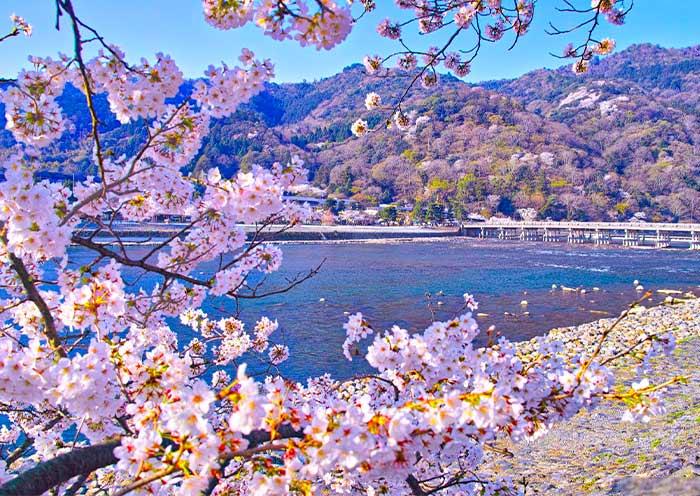


Attractions
5 Sites
Transportation
Vehicle
Dining
Breakfast
Accommodation
4-star hotel in Kyoto
It’s time to end your 17-Days China Japan Group Tour. You are free to explore Kyoto at your own pace or make your own way to the airport for your departure.
Thank you for choosing Asia Odyssey Travel (AOT) for your Asia Tour. We are always committed to providing you with exceptional experiences and look forward to welcoming you again on your next trip to Asia.
Attractions
/
Transportation
/
Dining
Breakfast
Accommodation
/
Nihao! Welcome to Shanghai, China’s most internationalized and vibrant city! Shanghai's long-term fusion of Eastern and Western cultures has contributed to Shanghai's unique culture. Upon your arrival at the airport/train station in Shanghai, the driver will meet and greet you at the exit, and then escort you to the well-selected hotel in downtown Shanghai. The rest of the day is free on your own so you can have a good rest for the jet lag or explore by yourself around your hotel.
Arrival Ideas:
Travelers can go to Shanghai easily by air or high speed train. There are two airports - Shanghai Pudong International Airport and Shanghai Hongqiao International Airport operating numerous international and domestic airlines. Travelers can go to Shanghai by air from most cities in China, like Beijing, Xian, Guangzhou, Chengdu, Guilin, Kunming, Lijiang, Lhasa, and more. In addition, travelers can take high speed train to Shanghai from Beijing (4.5-6 hours), Xian (6-7.5 hours), Huangshan (2.5-3 hours), Guangzhou (7-8.5 hours), Suzhou (0.5 hour), Hangzhou (about 45 mins), Wuhan (3.5-4.5 hours), etc.


Attractions
Explore freely today
Transportation
Arrive in Shanghai by yourself; vehicle
Dining
None
Accommodation
3-star hotel in downtown Shanghai
Today, your group will have full day to experience the perfect blend of East and West in the "Paris of the East." Explore brilliant museums, classical gardens, futuristic skyscrapers, and stunning architecture - all in one vibrant city.
First, head to Pudong and the Lujiazui financial district, home to a trio of iconic skyscrapers. The Shanghai Tower, China’s tallest and the world’s second-tallest building at 632 meters (2,073 ft), soars with a dramatic 120-degree twist from base to peak. Ride the world’s fastest elevators (64 km/h) to the "Top of Shanghai Observatory" on the 118th floor, 546 meters above ground. Enjoy breathtaking 360-degree views of the city, with the Jin Mao Tower and Shanghai World Financial Center below.
Later, visit the Shanghai Museum (East), one of the world’s finest museums of ancient Chinese art. Its sleek, modern design is inspired by the traditional Chinese jade bi disc. Inside, explore galleries of bronzes, ceramics, calligraphy, paintings, jade, furniture, coins, and sculptures. Don’t miss iconic treasures like the Da Ke Ding, a 3,000-year-old bronze vessel, displayed with the Zi Long Ding and Marquis of Jin Bells - a rare highlight of the Bronze Gallery. Also, see the legendary Sword of King Goujian of Yue, a masterpiece of ancient craftsmanship.
Next, visit Yu Garden, Shanghai’s most famous classical garden, hidden in the heart of the city. Stroll through elegant pavilions, rockeries, and lotus ponds, and admire exquisite carvings and traditional architecture. Outside, Yuyuan Bazaar offers local snacks, souvenirs, and handcrafted art.
In the afternoon, walk along Nanjing Road Pedestrian Street, lined with global brands, cafes, and historic buildings. End at the Bund, Shanghai’s top must-see landmark. Known as the "Exhibition of International Architecture," it features 52 grand buildings in Gothic, Baroque, and Art Deco styles. From here, enjoy a stunning view of the Pudong skyline across the Huangpu River.
Travel Notes:
- Yu Garden is closed on Mondays. In this case, we may visit the City God Temple, or French Concession
- Shanghai Museum (East) is closed on Tuesdays. You will visit Shanghai Museum (People’s Square) on that day. If access to the People’s Square location is unavailable, we will arrange an alternative city attraction.




Attractions
5 iconic sites
Transportation
vehicle
Dining
Breakfast, Lunch
Accommodation
3-star hotel in downtown Shanghai
On this day, you will have some free time till be met in the hotel lobby and escorted to the airport for your flight to Zhangjiajie (about 2.5 hours).
Welcome to Zhangjiajie, an incredible place where you can see Avatar Hallelujah Mountain in reality! Upon your arrival in Zhangjiajie, the local driver will greet you at the exit of the airport, and then escort you to your hotel in Wulingyuan Area. Enjoy some free time on your own after the hotel check-in.


Attractions
explore freely on your own
Transportation
vehicle
Dining
Breakfast
Accommodation
3-star hotel in Zhangjiajie
After breakfast, you will have a whole day to explore Wulingyuan Scenic Area, a spectacular island of nature dominated by more than 3,000 narrow quartz sandstone pillars. First, take a sightseeing bus to Bailong Elevator that within 1.5 minutes you can go from the valley bottom up to the pillar peak. It is the fastest and as well as the tallest outdoor elevator in the world. Next, enjoy the hike into a mysterious Pandora World - Yuanjiajie, where is rightly the shooting location of “Hallelujah Mountains” in reality. Catch the chance to shoot South Sky Pillar, the landmark of Yuanjiajie, about 150 meters high vertically rising high from the deep valley, looking like a giant standing so upright under heaven. Go to the Enchanting Platform for a marvel at the unbelievable scenery with hundreds of various peaks like bamboo shoots towering from the grounds. And then enjoy the lush scenery of Natural Bonsai at Backyard Garden.
Next, take the sightseeing bus to the second tourist site - Tianzi Mountain Nature Reserve which was named after the leader of the local Tujia ethnic group - Xiang Dakun in early Ming Dynasty (1368-1644). It is a fairyland in moive Monkey King. Hike to He Long Park which has a fascinating viewing deck to appreciate the incredible and magnificent scene of peculiar stone peaks. Move to Dianjiang Terrace to overlook the West Sea Stone Forest, rugged rock rising out of a misty canyon. The last stop today is the Ten-mile Galley. You will take a small green train to explore the beautiful scenery where you will feel like get through a Chinese ink painting. After the tour, get back to your hotel for a good rest.




Attractions
3 sites
Transportation
sightseeing bus
Dining
Breakfast, Lunch
Accommodation
3-star hotel in Wulingyuan
After breakfast, you will be transferred to the Zhangjiajie Grand Canyon for the breathtaking Grand Canyon Glass Bridge experience. The Grand Canyon Glass Bridge wants to say “hello” to you and makes you yell “my god” to give a deeper impression of Zhangjiajie. Suspended between two peaks, the glass bridge is 430 meters long and 300 meters high, which is the longest and highest glass bridge in the world. Standing on the transparent glass is like floating in the air and you can have superb panoramic view of the entire Grand Canyon.
After your “tremble” on the glass bridge, move to the Baofeng Lake to do a scenic cruise to bring you back to peace. Surrounded by green trees and stone peaks of various shapes, Baofeng Lake is an idyllic place for relaxation. When leisurely cruising on the boat, you can see the reflection of the marvelous peaks and enjoy the folk songs performed by the local minority people.




Attractions
2 sites
Transportation
vehicle
Dining
Breakfast, Lunch
Accommodation
3-star hotel in Wulingyuan, Zhangjiajie
After breakfast, your guide and driver will pick you up at your hotel lobby. Today, you will make a breathtaking visit to Tianmen Mountain, one of the world’s most beautiful mountains. You won’t miss the chance to experience the world’s longest cable car, walk on the glass skywalk, and pay a visit Heaven’s Door and view Avenue toward Heaven with 99 turns.
First, go to take the 30-minute cable car with 7,455 meters in length which means you’ll travel from the city of Zhangjiajie to the top of Tianmen Mountain. From the cable car you will have a perfect view of Heaven’s Door and a shocking look at the wandering Avenue toward Heaven. Next, move to Tianmen Temple where you can enjoy the typical Qing Dynasty styled Buddhist structure with verdant forest surrounding by.
Now, the challenge time is coming. Hold your breath to experience the scary walks on the cliff path hanging on the mountain. Walk on the Glass Skywalk, which is transparent glass 1430 meters above the bottomless valley, giving you a thrilling feeling like walking in the sky. Also, try the 1.6-kilometer-long Cliff-Hanging Walkway, built along the edges of the mountain’s summits. Amazing, isn’t it? After that, go down by escalator from the peak to Tianmen Cave which is also known as “Heaven’s Door”. Tianmen Cave is a natural arch between two peaks of a height of 131.5 meters, rising above the ground and closing to the sky with a lofty and towering posture. It is the highest hole of its sort in the world. (Note: Tianmen Mountain is the famous spot for Wingsuit Flying, you might have a chance to witness this unbelievable sport there.) After the memorable time, take the cable car down the mountain. And then, you will be transferred to Wulingyuan area and have accommodation here.
After the tour, it is time to say goodbye to Zhangjiajie. You will be escorted to the airport for your night flight to Xian (about 2 hours). Upon your arrival in Xian, the local driver will meet you at the exit of the airport and escort you to your hotel.
Optional Transfer Plan from Zhangjiajie to Xian in the Off-Season:
During the off-season, if there is no direct flight from Zhangjiajie to Xian, we will adjust the plan for you: transfer from Zhangjiajie to Changsha by high-speed train, and then take a flight from Changsha to Xian.


Attractions
1 site
Transportation
flight, vehicle
Dining
Breakfast, Lunch
Accommodation
3-star hotel in downtown Xian
After breakfast, your guide and driver will pick you up at your hotel. Drive about 40km (about 1 hour) to uncover one of the greatest archaeological discoveries in the world - the Terracotta Army Museum, built by the first emperor of China, Qin Shihuang, to protect him in the afterlife. Around 8,000 vivid life-size Terracotta Warriors have been found so far. First, visit the largest and most imposing pit, believed to contain over 6,000 terracotta figures of soldiers and horses. You will be amazed by this subterranean life-size army of thousands standing silently to guard the emperor. Marvel also at the fabulous artistic skills of ancient Chinese artisans. Next, move to another pit where you can see around 1,300 warriors and horses. Examine the ancient army formation, including the kneeling and standing archers, the chariot war array, and numerous troopers holding weapons.
After lunch, head to visit the Ancient City Wall, also known as the Fortification of Xian, representing one of the oldest, largest, and best-preserved Chinese city walls. Spend time leisurely walking the wall and enjoying its inner and outer walls, watchtowers, and moat, taking in panoramic views of modern Xian, there, you will also visit the awe-inspiring Bell Tower (or Drum Tower), a landmark from the Ming Dynasty dating back 600 years, will be beautifully illuminated, creating a captivating backdrop for stunning photos showcasing the harmonious blend of ancient history and modernity in Xian. In the evening, you may also have the chance to visit the lively Bell & Drum Tower Square (Zhongulou Square), allowing you to immerse yourself in Xian's vibrant nightlife like a local.

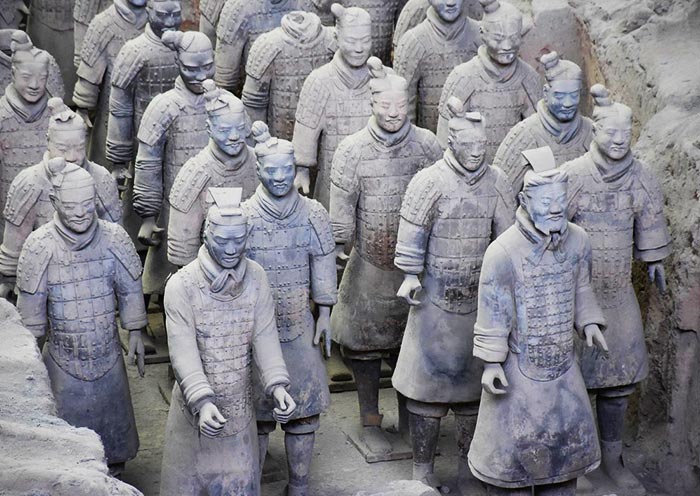
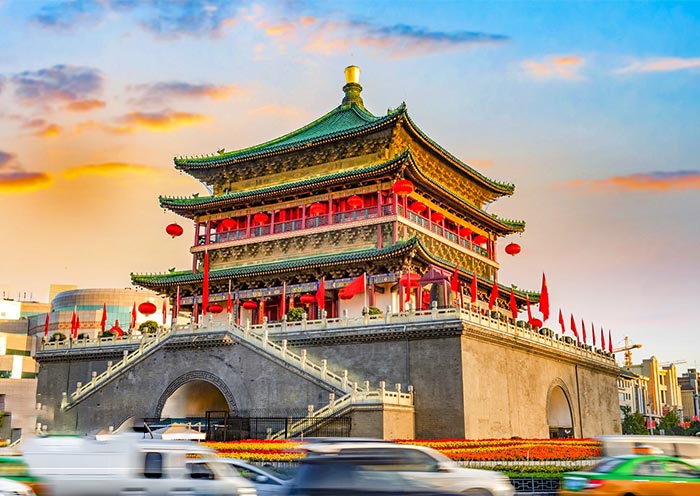
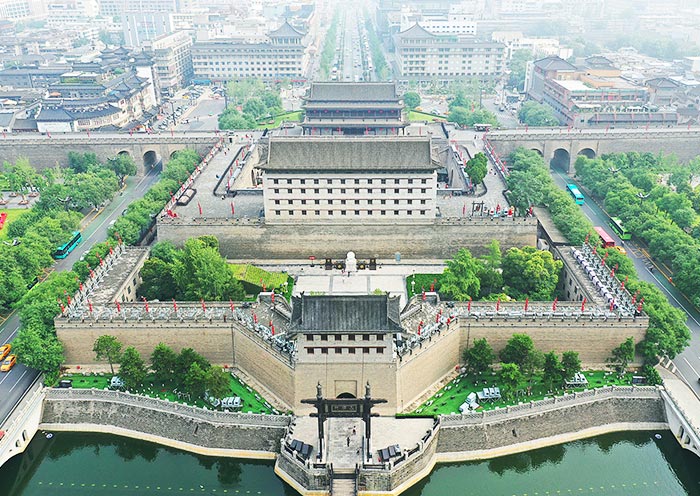
Attractions
3 sites
Transportation
vehicle
Dining
Breakfast, Lunch
Accommodation
3-star hotel in downtown Xian
In the morning, you will visit Giant Wild Goose Pagoda, one of Xi’an’s most recognizable landmarks and a symbol of the magnificence of the Tang Dynasty. This seven-story pagoda, standing in the tranquil Da Ci’en Temple, is one of China’s best examples of a Tang-style pagoda (squarish rather than round). It was completed in AD 652 to house Buddhist sutras brought back from India by the monk Xuan Zang. His travels inspired one of the best-known works of Chinese literature, Journey to the West.
Later, you will have the opportunity to explore the vibrant and bustling Muslim Quarter, one of the most famous neighborhoods in Xi’an. Stretching for about 500 meters, this area is home to the city’s Hui Muslim community. Enjoy the lively atmosphere and especially the mouthwatering street food. You can try famous Xi’an specialties such as Roujiamo, Yangrou Paomo, Biangbiang noodles, and kebabs.
After the tour, you will be transferred to the train station for your high speed train to next destination - Beijing. Upon arrival in Beijing, your driver will meet you at the train station and escort you to your hotel. The rest of the day is free on your own so you can explore by yourself around your hotel.


Attractions
2 sites
Transportation
high speed train, vehicle
Dining
Breakfast
Accommodation
3-star hotel in downtown Beijing
Today you will spend the whole day exploring the ancient citadel of Beijing through China's famous landmarks, imperial grandeur, and royal gardens.
After breakfast, your guide will pick you up at your hotel and head to Tiananmen Square, the world's largest public square and symbol of China. It has witnessed many major events in China's history over the past decades, and from here you can take great photos of Tiananmen Gate, seen daily on CCTV News.
Walking across the square, you will visit the mighty and splendid Forbidden City, the world's largest palace complex and former home of 24 Chinese emperors. Listed as a UNESCO World Heritage site, the Forbidden City has about 500 years of history, serving as the political and ritual center of China during the Ming (1368-1644) and Qing (1644-1911) dynasties. With over 8,700 rooms, it is not only China's largest and best-preserved collection of ancient buildings, but also a city within a city, like the Vatican in Rome. Enter through the Meridian Gate and visit along the central axis to ensure you see all the highlights. Admire the brilliant architecture and numerous ancient treasures while listening to your guide share stories of the emperors who once lived here. Later, take a 15-minute walk up to Jingshan Park, where you can enjoy magnificent panoramic views over modern Beijing and the Forbidden City's russet roofs. (Note: It requires some walking, so please wear comfortable footwear. You can decide whether or not to climb to the top based on your physical condition.)
In the afternoon, drive to the Summer Palace, the "Museum of Royal Gardens," once a summer retreat for royal families. The grounds, temples, gardens, pavilions, lakes, bridges, gate-towers, and corridors are marvels of landscape design. Take a leisurely stroll to appreciate the imperial architecture, hilltop views, and beautiful lakes, which offer a pastoral escape into the landscapes of traditional Chinese painting.
(Travel Note: Beijing's Forbidden City is closed on Mondays. On those days, you will instead visit the Temple of Heaven or Prince Gong's Mansion.)

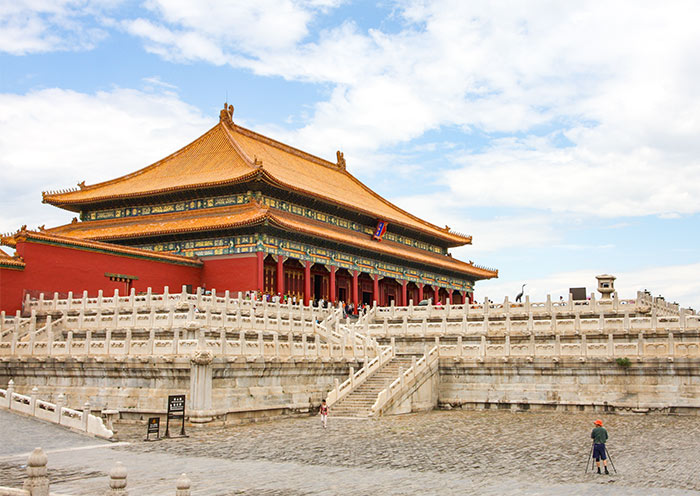


Attractions
4 iconic sites
Transportation
vehilce
Dining
Breakfast, Lunch
Accommodation
3-star hotel in downtown Beijing
In this morning, you will head northwest of Beijing (about 1.5-2 hours’ drive, 73km) to the Great Wall at Mutianyu. The Great Wall boasts a history over 2,000 years and stretches more than 3,000 miles across several provinces of northern China, making it one of the most impressive ancient masterpieces on the planet. Mutianyu Great Wall is connected with the Jiankou Great Wall in the west and the Gubeikou Great Wall in the east. Mutianyu is the longest and best fully-restored Great Wall with fewer tourists and is also famed for its 23 Ming-era watchtowers and stunning views. Take the cable car up to the 14th watchtower and then enjoy the memorable hiking time on the wall while visiting its western route. With the green pines and cypresses covering the surrounding area, and the winding wall standing majestically on the vast land, you will capture the most stunning natural scenery in this section. Challenge yourselves while climbing up to the 20th watchtower where you could fulfill your Great Wall dream. Cherish the chance and take photos as many as you like!
After the once-in-lifetime experience, head back to downtown Beijing and have the chance to take photos with the exterior of the Bird's Nest (Beijing National Stadium) and Water Cube (Beijing National Aquatics Center). They were both designed for the 2008 Beijing Olympics and used for the 2022 Winter Olympic Games.
After that, transfer back to your hotel and have a good rest tonight.




Attractions
3 sites
Transportation
Coach
Dining
Breakfast, Lunch
Accommodation
3-star hotel in downtown Beijing
You will have some free time in Beijing and explore more on your own till be escorted to the airport for your flight to Tokyo.
Konnichiwa (こんにちは)!Welcome to Tokyo, the capital city of Japan!
Upon arriving at the airport, you will transfer to the designated hotel in Tokyo. The accommodation in Tokyo will be a 4-star hotel in a convenient location.
Tokyo, the capital of Japan, is one of Japan and Asia's largest economic centers. Tokyo is a hub for Japanese culture and art, with numerous museums, art galleries, theaters, and cultural venues, serving as a vital platform for artistic activities and cultural exchanges. Tokyo stands as a significant base for technological advancement, nurturing numerous high-tech companies and innovative talents, holding leading positions globally in areas like electronics, automotive, and robotics technology.
Situated at the southern end of the Kanto Plain, Tokyo is surrounded by diverse natural landscapes including Mount Fuji, providing residents with leisure and outdoor activity spaces. At one point, the population of the Tokyo metropolitan area reached 36 million, accounting for one-third of Japan's total population. Despite the high cost of living, Tokyo provides residents with convenient living conditions, offering a plethora of shopping centers, entertainment facilities, and a rich culinary culture ranging from fine dining to street food.

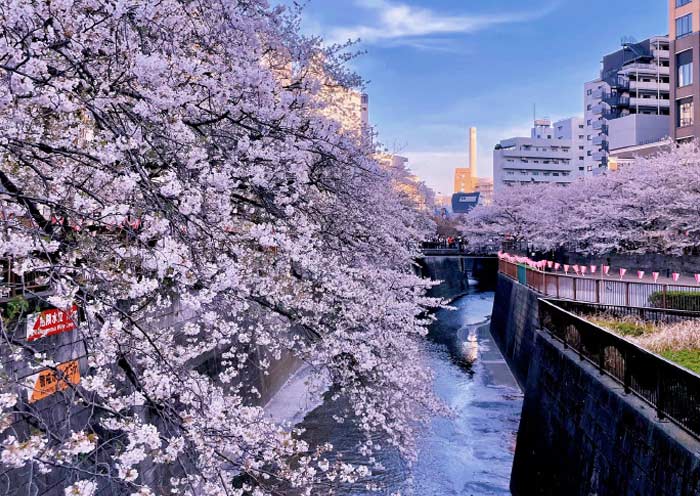


Attractions
0 Sites
Transportation
Vehicle
Dining
Breakfast
Accommodation
4-star hotel in Tokyo
Full day explore Tokyo & Sakura (Cherry Blossom). In the morning head to Ueno Park. It is one of the city's largest parks and one of Japan's most famous cherry blossom viewing spots, boasting over 1,300 cherry trees. The cherry blossoms bloom every spring, especially in early April, creating a breathtaking spectacle of falling cherry petals carried by the wind. The park is home to numerous museums and art galleries, including the Tokyo National Museum (Closed on Mondays) and the National Museum of Western Art (a World Heritage Site). In Ueno Park, you can also hear the calls of Japan's national bird, the crow, as they fly and search for food.
After that, head to Senso-ji Temple (Asakusa Kannon Temple), a must-visit for anyone traveling to Tokyo. Here, you can experience the heart of old Tokyo and its vibrant atmosphere. You can take photos that frame Senso-ji Temple and the Tokyo Skytree (Japan's Tallest Tower; 634 meters) together. Senso-ji Temple is a great place to view cherry blossoms in Tokyo! The temple is located in Asakusa, a popular neighborhood known for its cherry blossoms. There are several cherry trees in the temple grounds, as well as in the surrounding area.
Senso-ji Temple was built in 628 AD and has a history of over 1300 years, making it one of Japan's oldest temples. It not only witnesses Japan's historical changes but also carries a rich Buddhist culture. The architectural style of Senso-ji Temple blends Japanese traditional culture and art, with rich colors and exquisite carvings. The main buildings include the main gate (Kaminarimon; a landmark of Tokyo), the bell tower, the five-story pagoda (a landmark of Tokyo), and the main hall, all reflecting ancient Japanese architectural style and religious beliefs.
Kaminarimon is the iconic structure of Senso-ji Temple, towering at 11.7 meters high and 21.7 meters wide, truly spectacular. Giant red lanterns hang in front of the gate, with the words "Kaminarimon" prominently displayed. Kaminarimon is not only a symbol of Senso-ji Temple but also one of Tokyo's most famous landmarks. You may have seen the work of Utagawa Hiroshige, one of the "Three Greats of Ukiyo-e," in his piece "One Hundred Famous Views of Edo: Asakusa Kaminarimon," depicting a snowy scene of the Kaminarimon gate, celebrated for its delicate portrayal and profound imagery, becoming a masterpiece of Ukiyo-e art. The area is bustling, and crowded with people coming to pray and seek blessings for health, peace, and happiness. Around Senso-ji Temple, you can taste various Japanese cuisines, purchase unique souvenirs, and participate in various celebratory activities.
In this afternoon, visit Meiji Jingu Shrine (Meiji Shrine), a Shinto Shrine dedicated to Emperor Meiji (1852-1912) and Empress Shoken (1849-1914), who played a crucial role in modernizing Japan while excelled in writing Waka (traditional Japanese poems of 31 syllables in the pattern 5-7-5-7-7). Meiji Shrine is also a popular venue for traditional weddings, where you will have the opportunity to witness a Japanese wedding procession and experience the charm of Japanese traditional culture.
The Meiji Shrine is nestled within a tranquil forest that covers an area of 70 hectares, providing a peaceful escape from the bustling city. This forest is home to over 100,000 trees that were donated from regions across Japan during the shrine's construction, in honor of their beloved Emperor Meiji (who established Shinto as the state religion) and Empress Shoken.
Take a stroll along the paths and enjoy the fresh air and natural beauty. You will walk through Japan's largest wooden Torii gate, standing in its natural wooden hue and weighing up to 13 tons. The Torii gate serves as the Symbol of Shinto Shrines, marking the transition from the worldly to the sacred. Then, you will notice the impressive Sake Barrel Wall along the South Approach, which features offerings from sake breweries and believers across Japan, including barrels of sake and Western liquor, reflecting Emperor Meiji's fondness for Western culture.
At the main hall of Meiji Shrine, you can witness locals washing their hands and rinsing their mouths at Purification Font before worship as a sign of respect. You can offer a 5-yen coin (symbolizing a connection) like locals and pray for blessings. In the eyes of the Japanese, Meiji Shrine is considered to have such boundless capabilities, from naming ceremonies for newborns, to coming-of-age ceremonies, graduation ceremonies, seeking marriage partners, praying for world peace, family well-being, safe travels, good health, warding off calamity, etc.
In addition to immersing yourself in Japanese Shinto traditions and architecture, revel in the enchanting surroundings filled with lush trees, serene ponds, graceful bridges, and stone pathways that epitomize the essence of traditional Japanese garden art. You should visit here to enjoy the vibrant bloom of cherry blossoms in spring, the verdant beauty of summer, the fiery hues of autumn leaves, and the serene snowy landscapes of winter.
Tips for Visiting Meiji Jingu Shrine:
- Wear modest clothing: Respect the sacred nature of the shrine by dressing appropriately.
- Be mindful of noise levels: Maintain a quiet and respectful atmosphere.
- Inner Garden (Optional; self-pay; once Imperial Property), and Meiji Jingu Museum (Optional; self-pay; items used by the imperial couple).
Then, move to visit Shibuya Crossing, one of the busiest intersections in the world, accommodating approximately 3,000 people per minute. As one of Tokyo's iconic locations, Shibuya attracts tourists and photographers from around the globe who come to observe and capture its essence. Numerous movies, TV shows, commercials, and music videos are filmed at this location, such as "The Fast and the Furious: Tokyo Drift." Additionally, if you're interested in the story of Hachiko, the loyal dog, you can also visit his bronze statue. This Hachiko Statue is located outside Shibuya Station and was erected to commemorate Hachiko's loyalty. Not only is it a popular meeting spot, but it's also a must-visit attraction for tourists. The statue symbolizes the power of loyalty and love, serving as a touching tribute.
Stay overnight in Tokyo.




Attractions
4 Sites
Transportation
Vehicle
Dining
Breakfast
Accommodation
4-star hotel in Tokyo
Today, it will be a full-day round trip to admire the breathtaking views of Mount Fuji from Lake Kawaguchi,
Mount Fuji is the tallest mountain in Japan. It's a famous volcano with a perfectly symmetrical cone shape. Visiting Mount Fuji is essential for any traveler in Japan. As a UNESCO World Heritage Site, Mount Fuji (3,776m) stands as an iconic symbol of Japan, a cultural and spiritual landmark (recognized as a holy mountain in Shintoism), and a natural marvel. When picturing Mount Fuji, its distinctive perfect cone shape and snow-capped peak likely come to mind. Among the most renowned depictions is Katsushika Hokusai's 'Thirty-Six Views of Mount Fuji'. Hokusai, one of the "Three Greats of Ukiyo-e", is best known for his masterpiece "The Great Wave off Kanagawa" which can be seen on the 1,000 Japanese yen bill.
Start your journey to Arakurayama Sengen Park on the way to Lake Kawaguchi. Arakurayama Sengen Park is a popular destination for viewing cherry blossoms, renowned for its early blooming sakura trees. The park features Kawazu zakura, a unique variety of cherry trees known for its large, pink blossoms. The park's cherry trees typically bloom earlier than those in other regions of Japan, making it a great choice for those who want to experience the beauty of Sakura in February or early March. The park offers breathtaking views of the Kawazu River and surrounding mountains (framing Mt. Fuji, Sakura & Five-story pagoda together), providing a picturesque backdrop for your cherry blossom experience. During the peak cherry blossom season, the park hosts a lively festival with food stalls, traditional performances, and other festivities. Hike about 15-20 minutes up to Arakurayama Sengen Shrine, dedicated to the mountain god. The shrine is surrounded by beautiful gardens and offers a peaceful atmosphere. Enjoy the gorgeous scenery and capture iconic photos at the famous Red Fuji Observation Deck.
Next, head to Lake Kawaguchi, another excellent location to leisurely view Mount Fuji. The lake boasts crystal-clear waters, providing breathtaking views of the iconic mountain and a serene atmosphere. Enjoy a cruise on the tranquil waters to marvel at the stunning reflection of Mt. Fuji in Lake Kawaguchi. Additionally, take a leisurely stroll around the lake and explore the nearby parks, galleries, and museums based on your interests.
After that, head back to Tokyo overnight and have a good rest.
Notes:
It is a long day trip, and there will be a surcharge if the tour exceeds 8 hours (For Guide, driver & vehicle).
If the weather is clear, you can enjoy a good view of Mt. Fuji. However, if the weather is not favorable, Mt. Fuji may not be visible.
The best time to view Mount Fuji is generally from December to February when skies are clearer and the peak is snow-capped. And also, April to May (for blooming cherry blossoms) and October to November (for the autumn foliage) are good times.
Early mornings often provide the best visibility before clouds obscure the view. Different locations around Mount Fuji offer varying perspectives, with some spots known for their clear views.


Attractions
2 Sites
Transportation
Vehicle, Cruise
Dining
Breakfast
Accommodation
4-star hotel in Tokyo
On this day, your driver in Tokyo will take you to the train station, where your group will board the Shinkansen (bullet train) to Kyoto. Shinkansen Ride Experience: At Tokyo Station, board the Shinkansen bound for Kyoto Station (about 2.5 hours). This fast and comfortable journey offers an opportunity to enjoy the changing landscapes of urban and rural Japan.
Upon arrival in Kyoto, your driver will greet you and transfer you to your hotel. Check in, take some time to settle in, and rest.
Kyoto, located in the Kansai region of the country, was once the capital of Japan. It epitomizes ancient Japan and is famous for tranquil temples, exquisite gardens, colorful shrines, grand imperial palaces, and ornate castles. Boasting 17 UNESCO World Heritage Sites, over 1,000 Buddhist temples, and more than 400 Shinto shrines, Kyoto is among the world's most culturally rich cities. It's also known for traditional Japanese arts and practices, such as tea ceremonies, kaiseki dining (a traditional multi-course meal), and ikebana (flower arranging). It remains one of the best places to see geishas, who are traditional Japanese female entertainers known for their refined skills in arts, music, dance, and conversation.
Free Time Ideas in Kyoto:
Evening Stroll Along the Kamo River: This river flows through the city and provides walking paths with beautiful views. Many cafes and restaurants along the river have terraces, perfect for a relaxing end to your day.
Walk the Philosopher's Path: Enjoy a peaceful walk along the Philosopher’s Path, a stone path lined with cherry trees that follows a canal in northeastern Kyoto. This path is especially beautiful during cherry blossom season but offers a serene experience year-round.


Attractions
/
Transportation
Shinkansen, Vehicle
Dining
Breakfast
Accommodation
4-star hotel in Kyoto
In the morning, visit Kiyomizudera Temple, a UNESCO World Heritage Site. Perched on the hillside of Eastern Kyoto, this temple is renowned for its wooden stage that juts out over the hill, providing stunning views of the city and the surrounding nature. The temple's main hall, constructed entirely without the use of nails, is an architectural marvel. Kiyomizu-dera is also celebrated for its sacred waters, which are believed to have wish-granting powers that draw countless visitors who come to drink from its stream. Don’t miss the Hondo (Main Hall), Jishu Shrine, the Otowa Waterfall, and the spiritual experience of the Tainai-Meguri room.
Tips: The scenery at Kiyomizu-dera Temple is distinctively beautiful in each season, offering a unique charm year-round. In spring, the mountains are adorned with charming cherry blossoms; in summer, they are lush with vibrant greenery; in autumn, they are decorated with brilliantly colored leaves; and in winter, they are filled with enchanting trees. You will enjoy the soft pink sakura ice cream (specially prepared for free by Asia Odyssey Travel) while having a wonderful time here.
Then, walk up the well-preserved streets of Ninenzaka and Sannenzaka. These charming, sloping streets are lined with traditional shops and quaint tea houses, offering a nostalgic glimpse into Kyoto's past. As you stroll through these areas, you can shop for unique crafts, sample local snacks, and perhaps stop at a café to relax and soak in the atmosphere of old Kyoto.
Continue to Maruyama Park for viewing Sakura. Located near Kiyomizu-dera Temple and Gion District, Maruyama Park is renowned for its stunning display of sakura, particularly the iconic weeping cherry tree (shidarezakura) near the shrine. The park is home to Yamataka-no-Otoko Shrine, a popular Shinto shrine that attracts many visitors throughout the year.
Next, move to Gion which is Kyoto's famous geisha district. Here, you might catch a glimpse of Geisha (Geiko) in their elaborate kimonos and traditional makeup. As you wander through the cobblestone streets of Gion, take a moment to appreciate the beautifully preserved machiya (wooden townhouses), ochaya (teahouses), and exclusive ryotei (traditional Japanese restaurants). Gion is particularly enchanting at dusk when the lanterns are lit and geishas and maiko (apprentice geishas) make their way to evening appointments, making the narrow lanes come alive.
The final activity today is to experience a traditional tea ceremony in an authentic setting, following the artful rituals and savoring the tea. Immerse yourself in the philosophy behind the ceremony.
After the tour, your group will be escorted to your hotel in Kyoto.

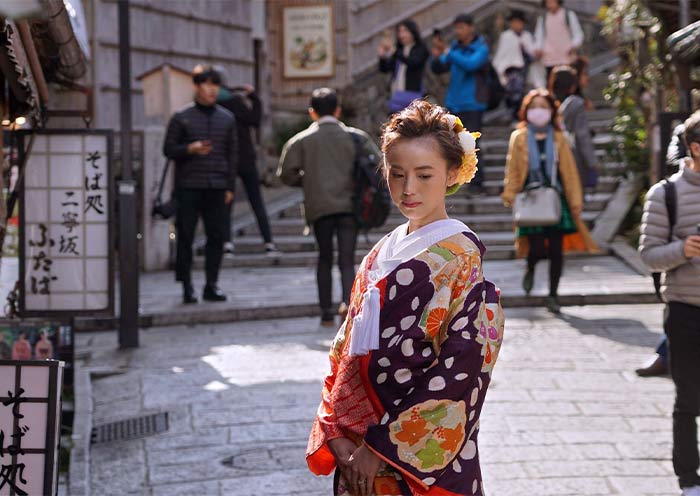

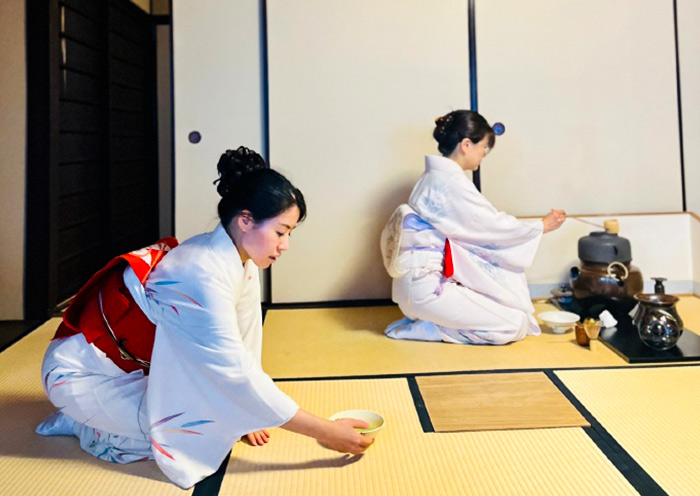
Attractions
5 Sites
Transportation
Vehicle
Dining
Breakfast
Accommodation
4-star hotel in Kyoto
Today, you'll be visiting some of Kyoto's most iconic spots, then head to the Arashiyama and Sagano areas located in the northwest of Kyoto. This itinerary will not only allow you to deeply experience Kyoto's culture and history but also bring you closer to nature, letting you feel the changes of the seasons.
Start your day with a visit to one of Kyoto's most iconic sights, Kinkakuji Temple (Golden Pavilion) - a UNESCO World Heritage site. This Zen Buddhist temple is famous for its stunning golden exterior. The temple's stunning visual appeal comes from its top two floors, which are completely covered in gold leaf. The reflection of the golden structure shimmering in the pond in front of it, makes it perfect for photos and quiet reflection. It was originally built in 1397 as a retirement villa for Shogun Ashikaga Yoshimitsu. After Yoshimitsu's death, as per his will, the villa was converted into a Zen temple by his son.
Next, head to Nijo Castle, another UNESCO World Heritage site, to delve deeper into Japan’s feudal history. Constructed in 1603 as the Kyoto residence of Tokugawa Ieyasu, the first shogun of the Edo period, its expansive grounds and ornate architecture highlight the power and wealth of the dominant samurai clans during the Edo period (1603-1867).
The castle features two concentric rings of fortifications, each consisting of a wall and a wide moat. After passing through the grand Kara-mon (gate), you will enter Ninomaru Palace, which is divided into five buildings with numerous chambers. The interiors are adorned with masterful paintings by the Kano school, reflecting the cultural and artistic heritage of the era. The castle is renowned for its "nightingale floors," (that sing and squeak at every move, making it difficult for intruders to move about quietly), designed as a security measure against intruders. Don’t miss the excellent Ninomaru Palace Garden, which was designed by the tea master and landscape architect, Kobori Enshu. Nijo Castle holds a significant place in Japanese history. It was at Nijo Castle in 1867 that Tokugawa Yoshinobu, the 15th and last shogun of the Tokugawa dynasty, declared the restoration of imperial rule, leading to the Meiji Restoration. This event marked the end of the shogunate system in Japan and the beginning of modern Japan as a nation-state.
This afternoon, you will fully explore the Arashiyama area in the western part of Kyoto. Based on Sakura season ticket availability, take one of the following two experiences:
Option 1: Sagano Scenic Railway Experience (25-30 minutes)
The Sagano Scenic Railway is a sightseeing train line running between Arashiyama and Kameoka. The train travels along the Hozugawa River gorge, offering breathtaking views of the surrounding forests and mountains. During spring, the old-fashioned train moves at a leisurely pace, allowing you to marvel at the stunning sight of pink cherry blossoms blanketing the forests and hillsides.
Option 2: Yakatabune (Houseboat Pleasure Boat, 30 minutes)
Enjoy a tranquil ride on traditional Yakatabune. As you glide along the Hozugawa River, take in the enchanting views of cherry blossoms lining both sides of the river. The serene scene of pink petals drifting on the water creates a poetic and picturesque atmosphere - truly an idyllic experience.
And then, walk to the nearby Arashiyama Bamboo Grove. The famous pathway is surrounded by towering bamboo, which creates an otherworldly atmosphere. This path leads you through one of Kyoto's most photographed landscapes.
After a short walk, explore Tenryuji Temple which is designated as a UNESCO World Heritage Site and is one of the so-called Kyoto Gozan or "five great Zen temples of Kyoto". Don't miss the garden, designed by the famous Zen master Muso Soseki, which reflects the concept of shakkei ("borrowed landscape"). Tips: The temple and its gardens are particularly beautiful during the cherry blossom season in spring and the colorful foliage season in autumn.
Conclude your visit to Arashiyama by walking to the Togetsukyo Bridge, an iconic historical wooden bridge offering picturesque views of the surrounding mountains and river, encapsulating the tranquil beauty of the area.
After the tour, drive back to Kyoto downtown. Stay overnight in Kyoto.




Attractions
5 Sites
Transportation
Vehicle
Dining
Breakfast
Accommodation
4-star hotel in Kyoto
It’s time to end your 17-Days China Japan Group Tour. You are free to explore Kyoto at your own pace or make your own way to the airport for your departure.
Thank you for choosing Asia Odyssey Travel (AOT) for your Asia Tour. We are always committed to providing you with exceptional experiences and look forward to welcoming you again on your next trip to Asia.
Attractions
/
Transportation
/
Dining
Breakfast
Accommodation
/
Choose Your Travel Date and Get Free Enquiry
| Month | Available Date | Price | Book The Tour |
|---|---|---|---|
| Mar | Mar.22, 2026 | from $5116 | Free Enquiry |
| Mar.29, 2026 | from $5116 | Free Enquiry |
|
| Apr | Apr.05, 2026 | from $5236 | Free Enquiry |
| Apr.12, 2026 | from $5236 | Free Enquiry |
Price: What’s Included & What’s Excluded
What’s Included:
What’s Excluded:
Hotel Selections for China Japan Group Tour



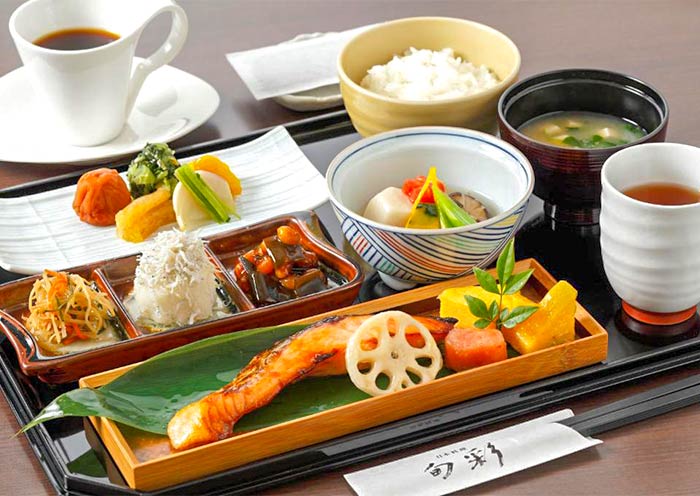
In a China Japan group tour, you will stay in well-selected 3-star hotels in China and 4-star hotels in Japan, located in convenient areas at each destination. All hotels feature windows, air-conditioning, hot water, showers,and Wi-Fi to ensure a comfortable stay.
You will share a standard twin room (two beds) with your travel partner. If you are traveling as a family of two, sharing the same room will be ideal. If you prefer to have your own room, a single room supplement will apply.
Please note: specific hotel requests cannot be accommodated for group tours. Hotel details will be confirmed three days before your tour begins.
Important Trip Notes for Booking a China Japan Group Tour
- Minimum Requirement: All tours are designed to depart with a minimum of 1 passenger.
- Group Size Limit: The maximum number of passengers per group (cap) is 16.
- Cancellation Clause (Standard): If a tour departure date has 0 bookings 30 days prior to the scheduled departure date, the tour departure will be automatically canceled by default.
Cancellation Policy
In the event that you need to cancel your trip, please ensure that you submit a written cancellation request. The calculation of cancellation fees will begin from the date we receive your written request.
The cancellation fees will be calculated as follows:
- 31-60 days prior to the departure date: a fee of 30% the total tour price will apply.
- 16-30 days prior to the departure date: a fee of 80% of the total tour price will apply.
- 0-15 days prior to the departure date: a fee of 100% of the total tour price will apply.
Your Worry-free Choices with Asia Odyssey Travel
Cancellation Policy
We provide a transparent overview of applicable fees.
Travel Insurance
Be covered for any unforseen circumatances.
Latest China Group Tours Reviews from Our Customers

christine l
Destination(s): Beijing, Xian, Shanghai, Guilin/Yangshuo, YangtzeRiver
Date of Experience: Apr 26, 2024
Tour Customized by: Vincent
You May be Interested in This Tour: Customized Tour

Scenic56196548232
Destination(s): Tibet
Date of Experience: May 28, 2024
Tour Customized by: Kayla
You May be Interested in This Tour: Customized Tour

customer
Trinidad
Destination(s): Beijing, Xian, Shanghai, Guilin/Yangshuo, YangtzeRiver
Date of Experience: May 03, 2024
Tour Customized by: Vincent
You May be Interested in This Tour: Customized Tour

